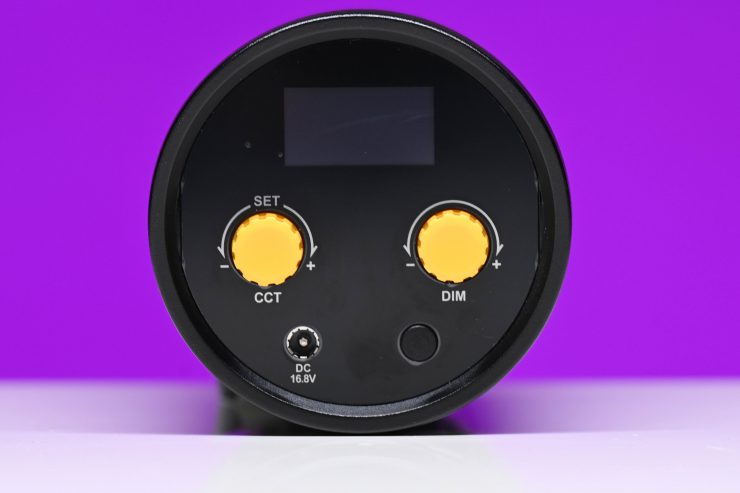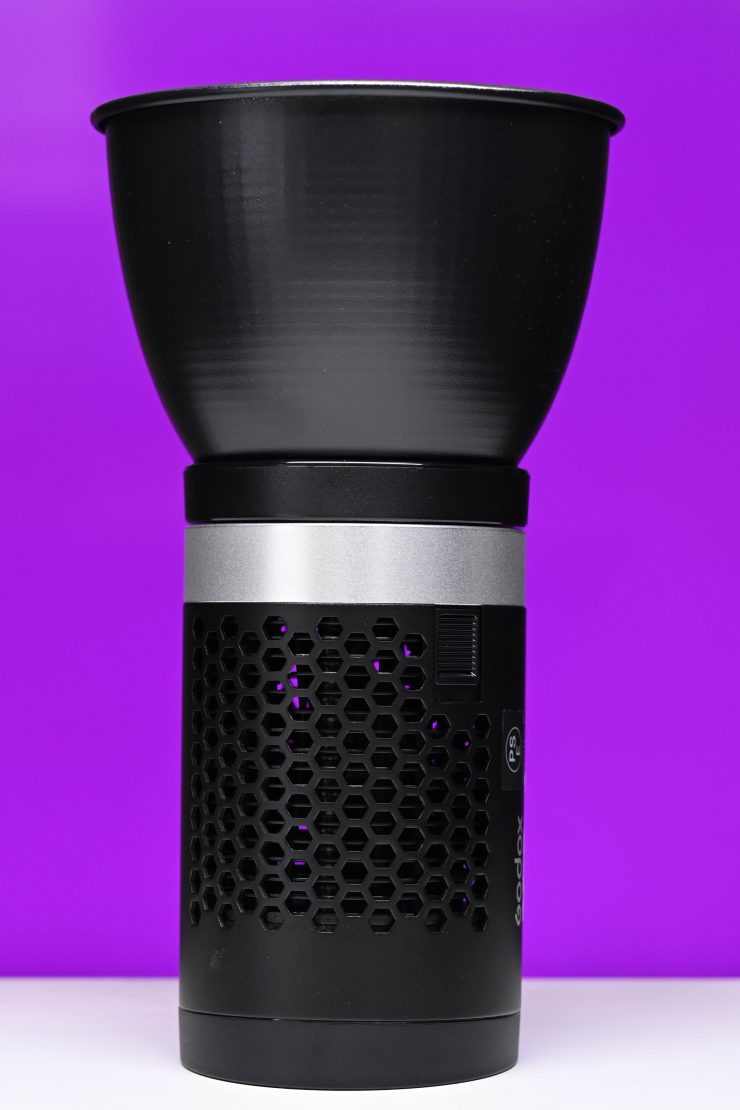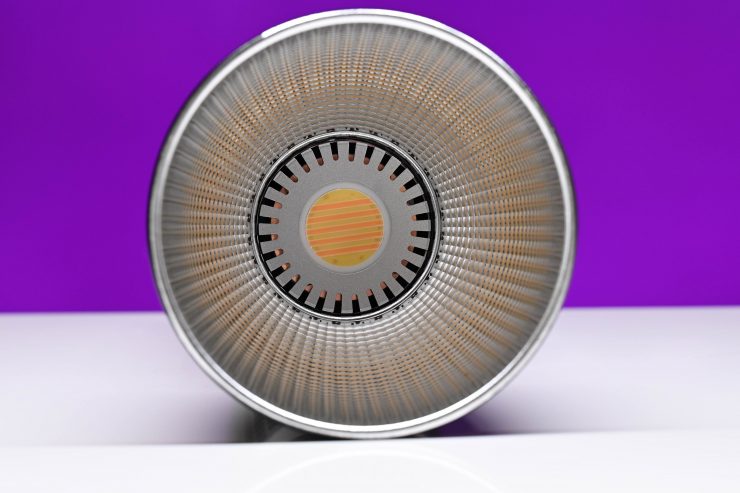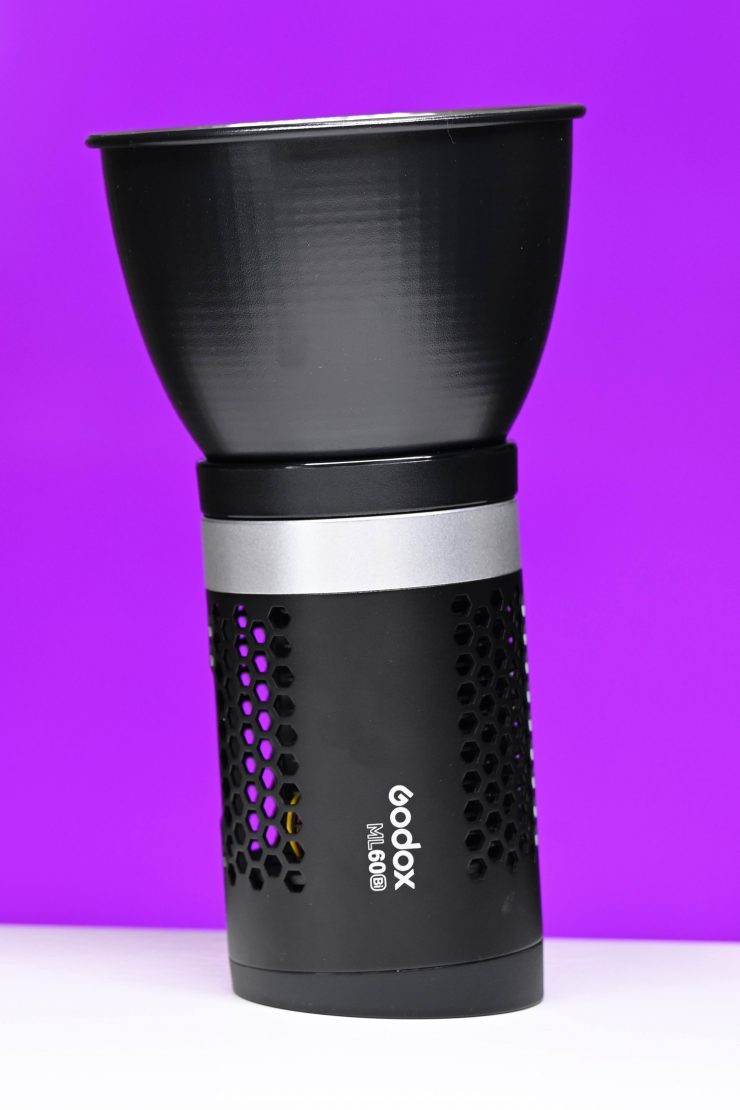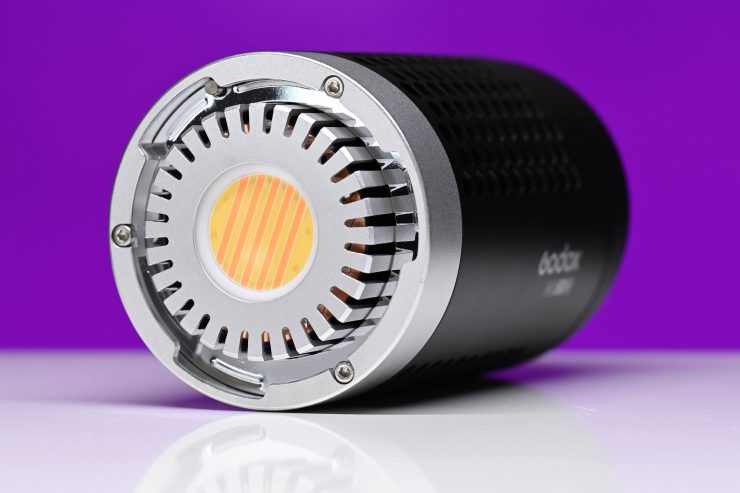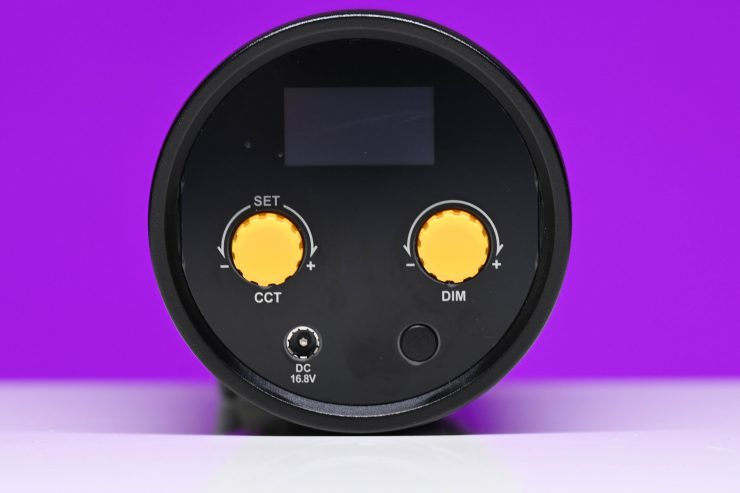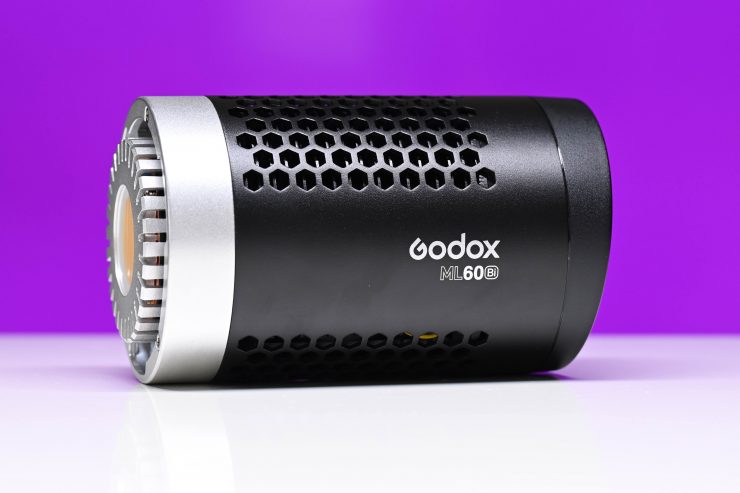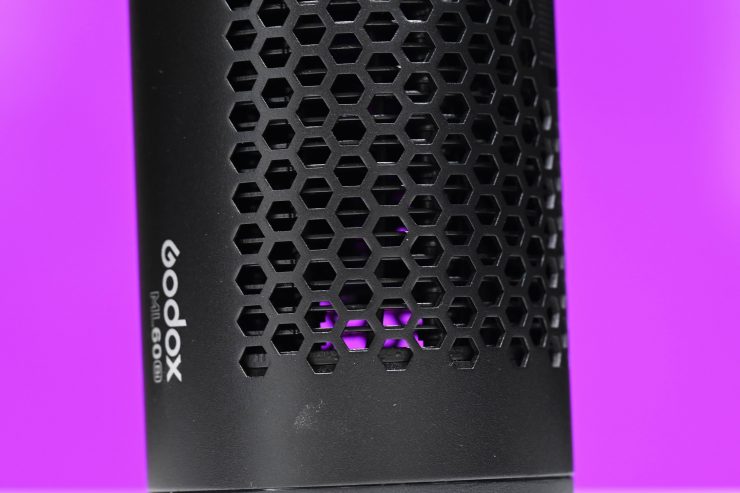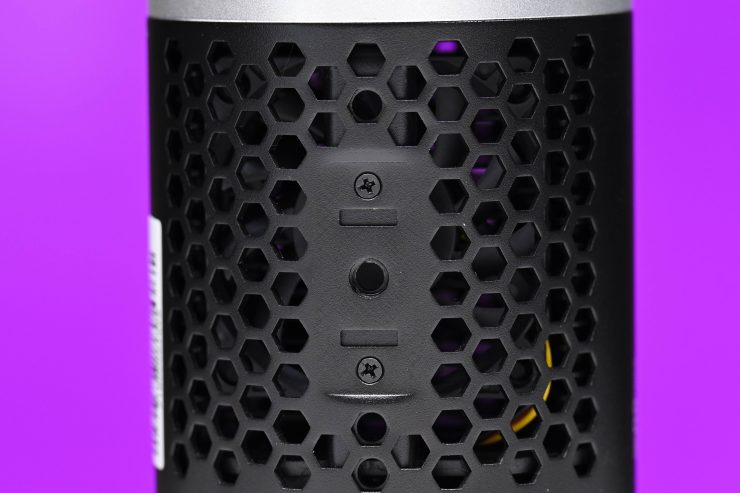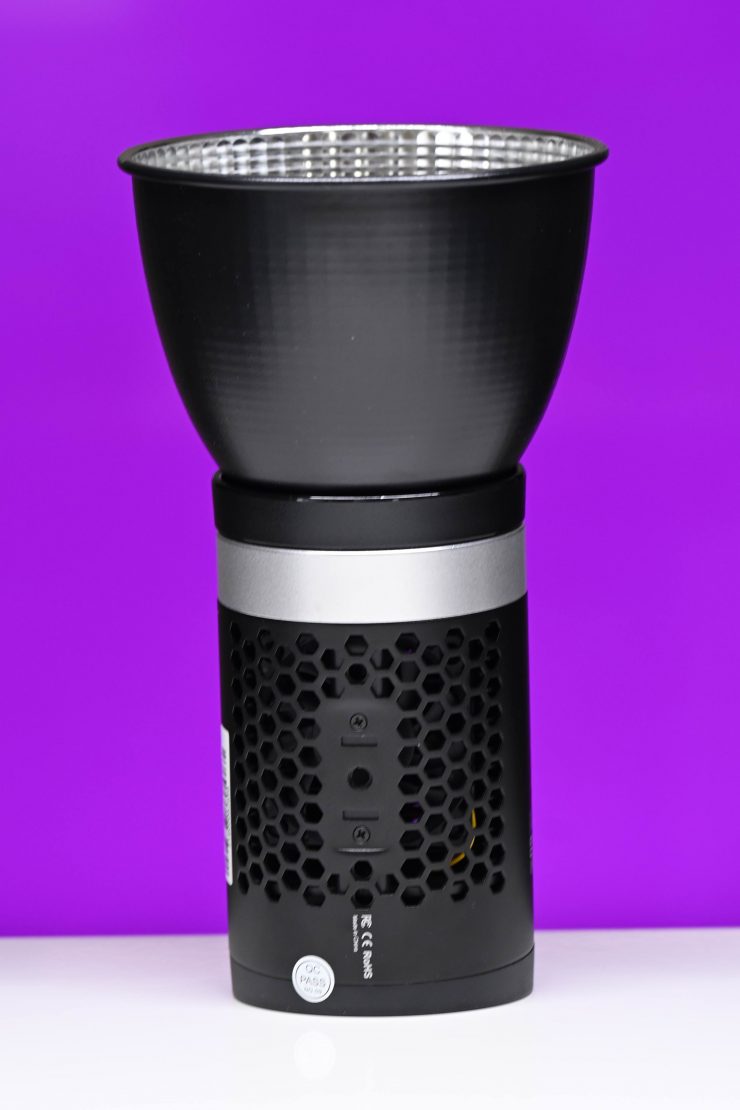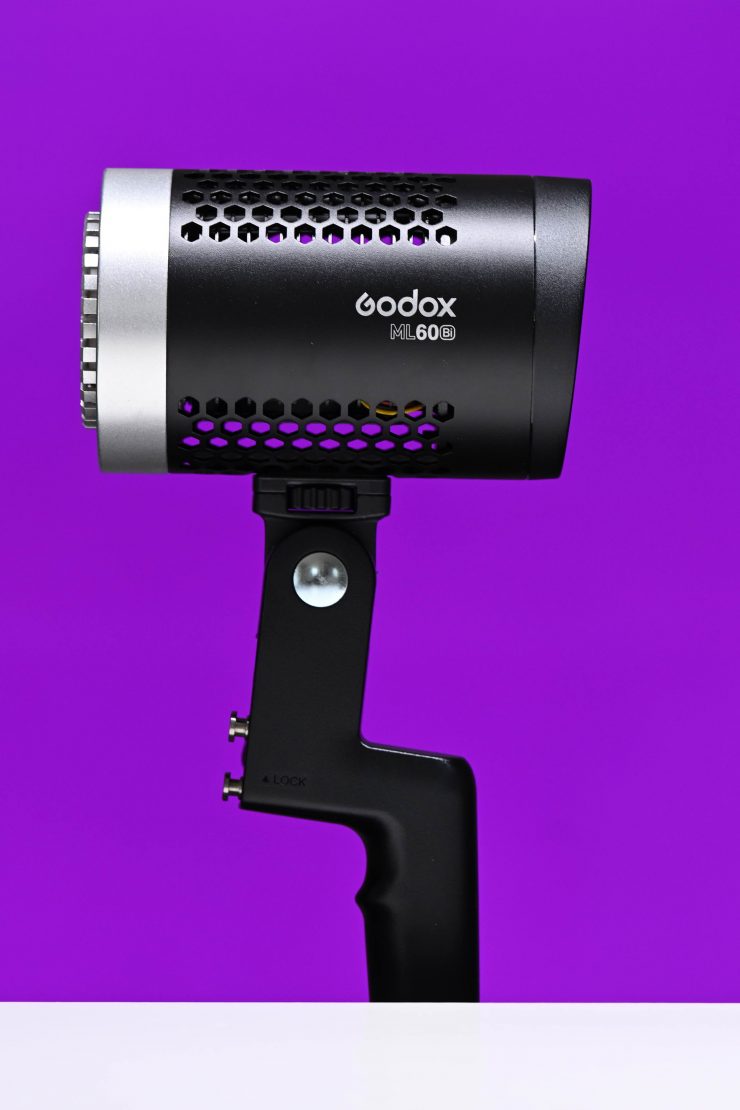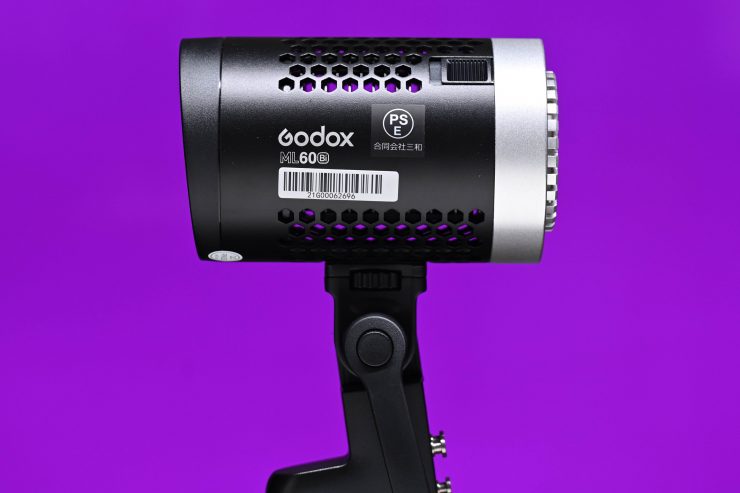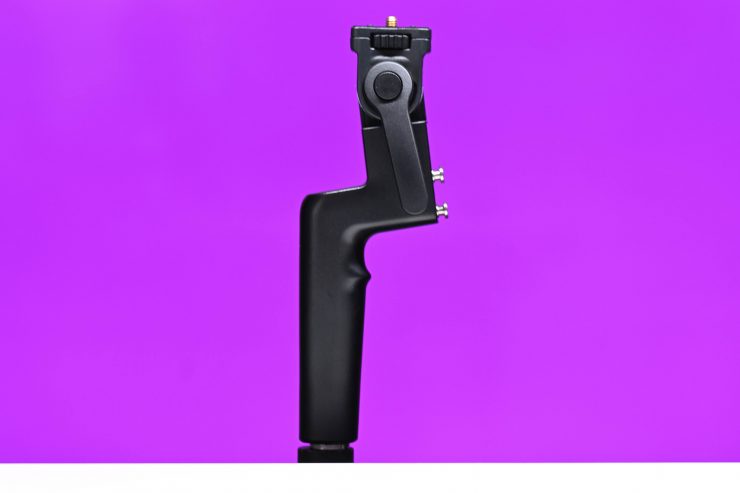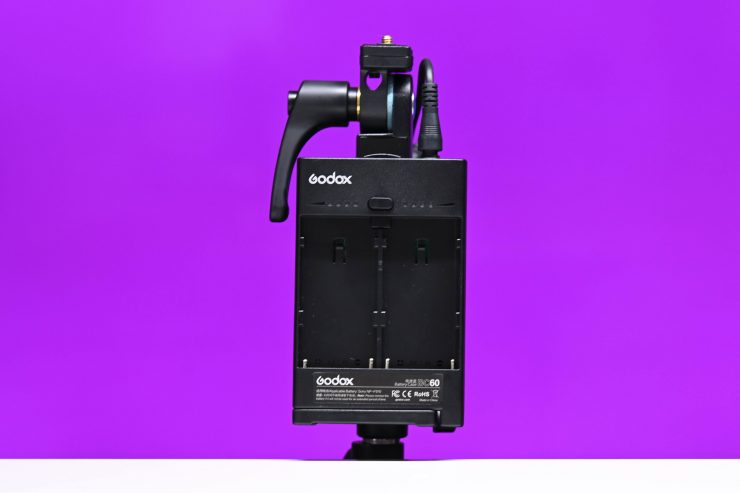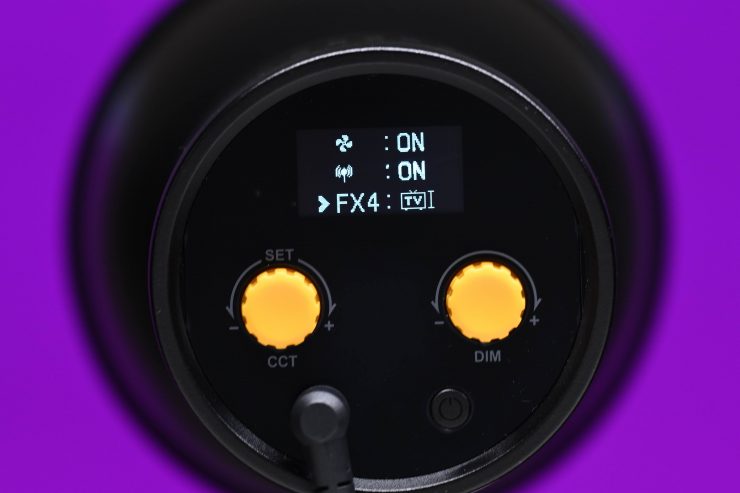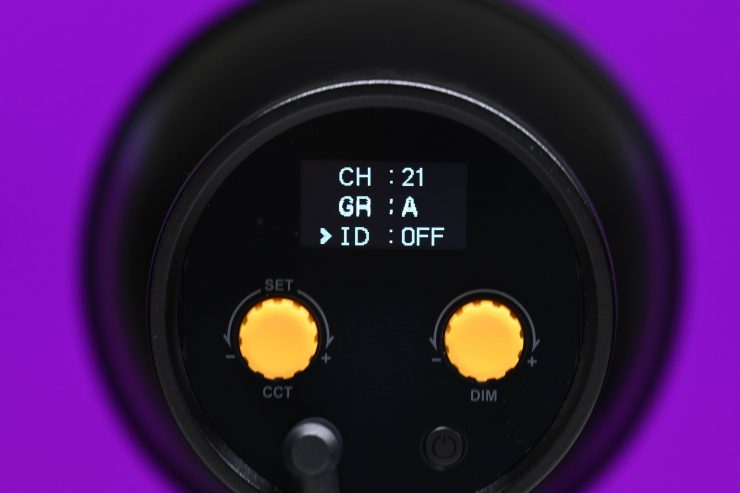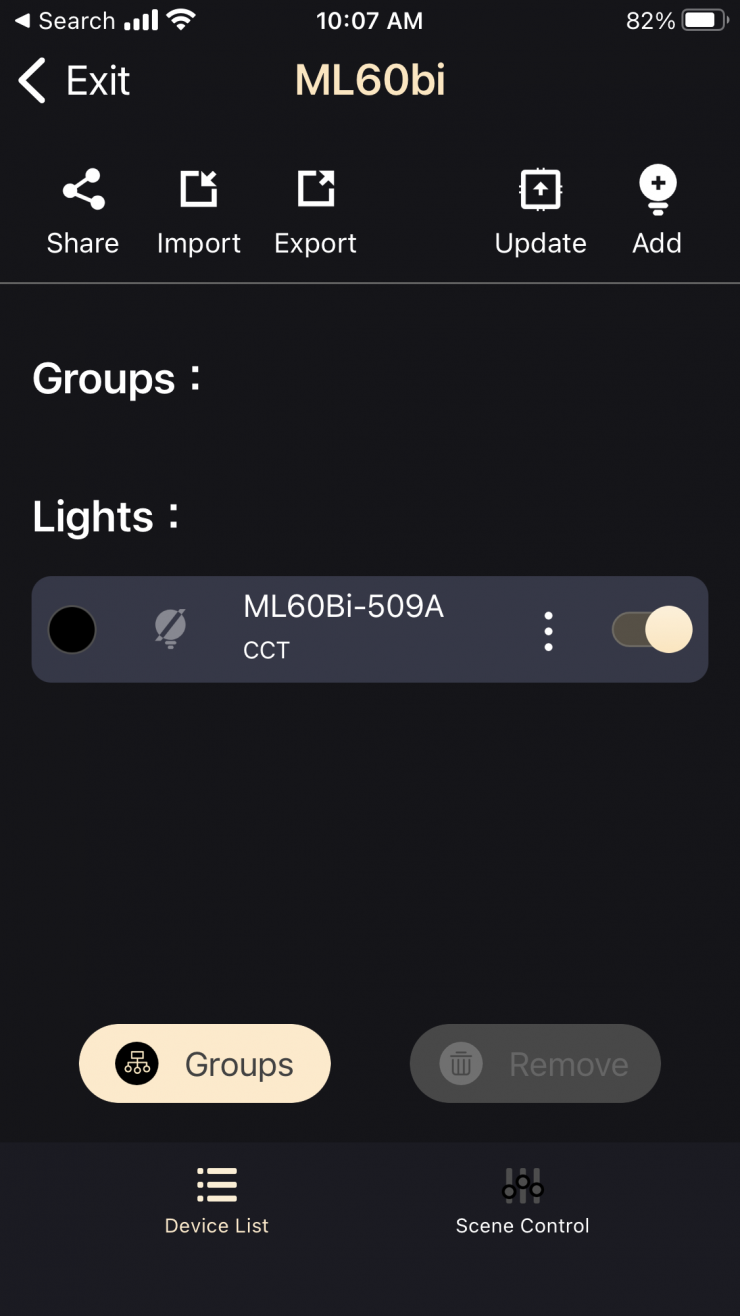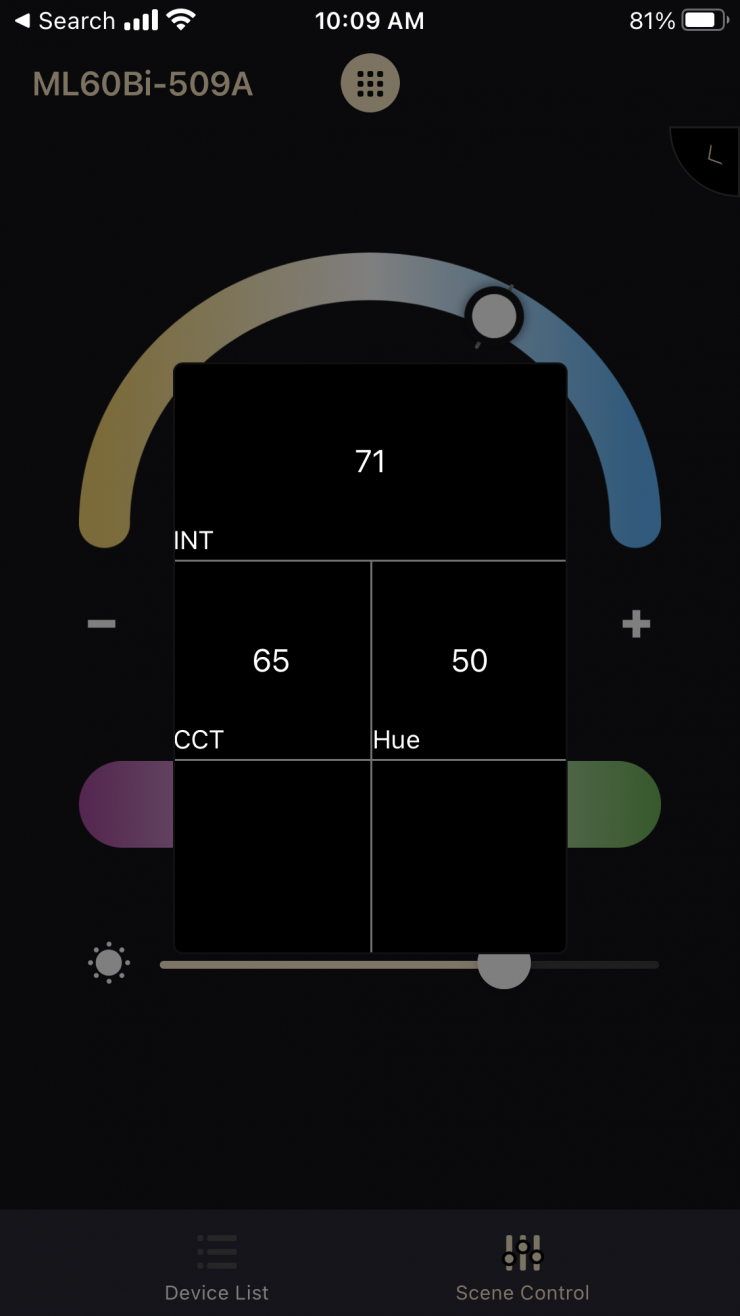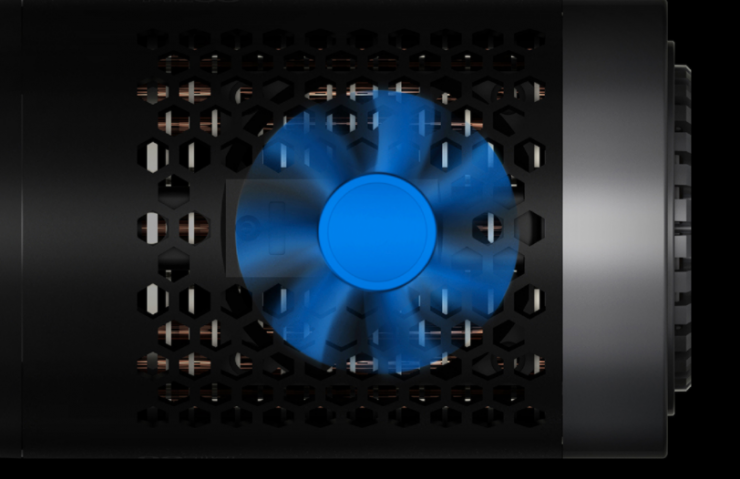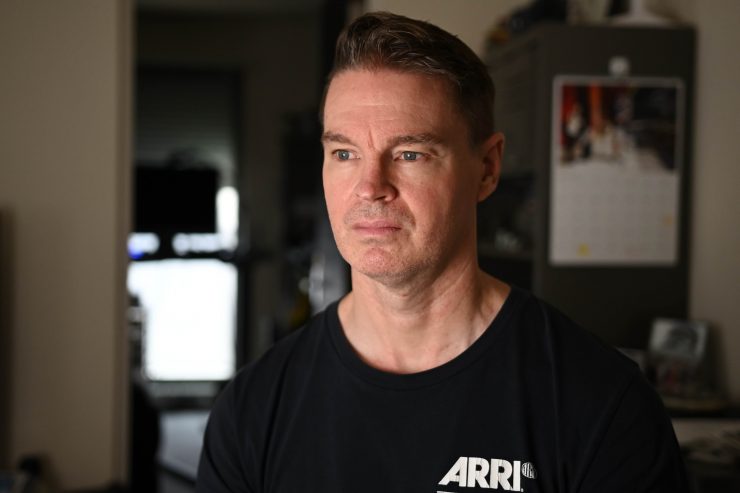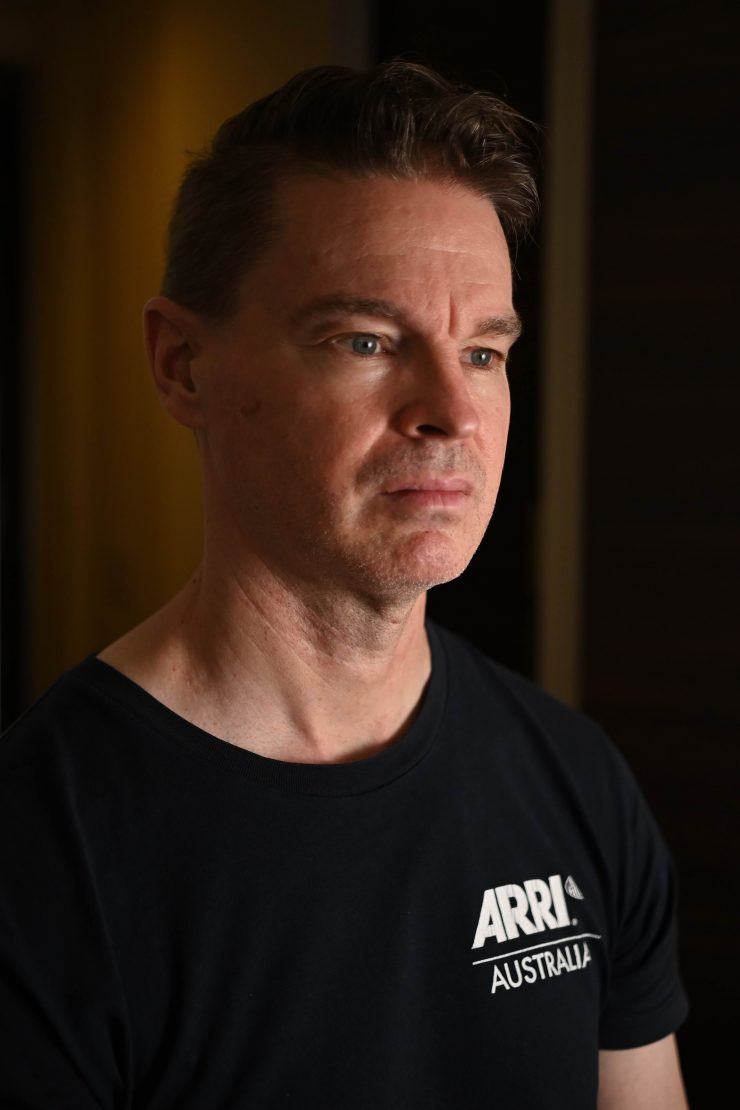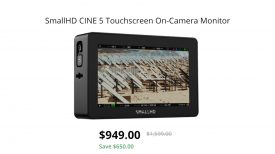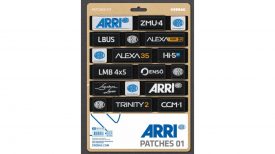
The Godox ML60bi, as its name suggests, is a bi-color version of the popular Godox ML60. It is being touted as a bright, high color accuracy fixture in a durable and lightweight body.
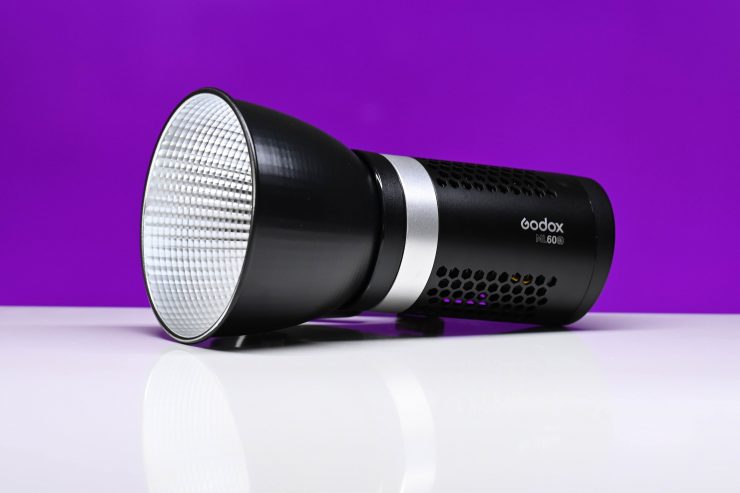
Versatile COB lights in this form factor have become increasingly popular due to their swiss army knife style abilities, which enable them to be used for a variety of lighting scenarios. Small-sized versions of these lights are popular because they can easily be powered and don’t take up much space in a bag. This is especially true with the ML60bi.
Key features
- Color: 2800-6500K
- CRI/TLCI: 96/97 (claimed)
- Dimming: 0-100%
- Includes Reflector
- Godox App 2.4 GHz Wireless Control
- 32 Channels, 16 Groups
- Optional Remote
- 60W Draw
- AC Adapter
- Removable Handle
- 7 Lighting FX
The Godox ML 60bi looks to be a good budget lighting solution, so without further ado, let’s get on with the review.
Concept
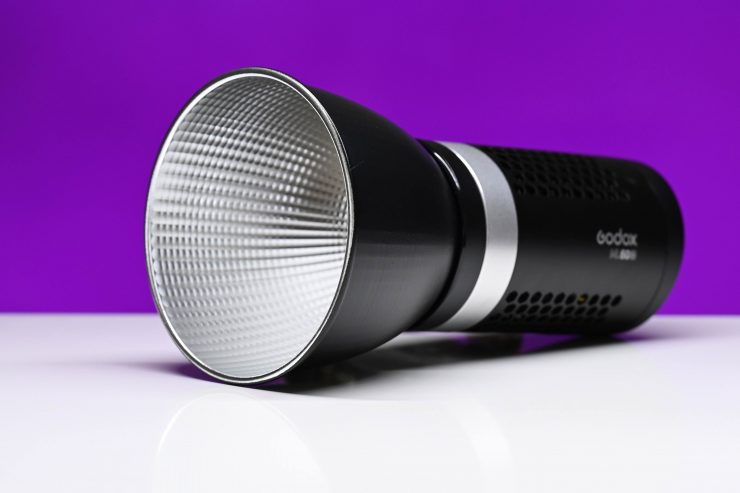
The concept is pretty simple, make a high output, color-accurate fixture that can be easily powered, doesn’t weigh much, and doesn’t cost a ton of money. This concept is very similar to what most other manufacturers are trying to achieve when building lights such as this.
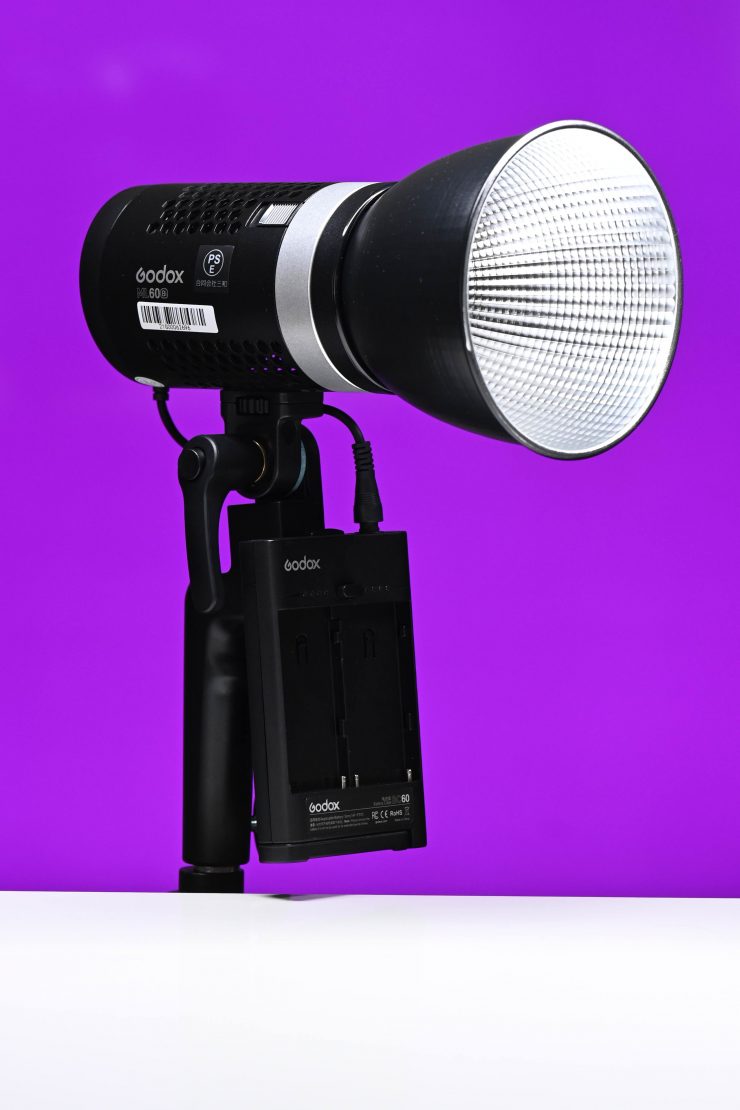
Build Quality
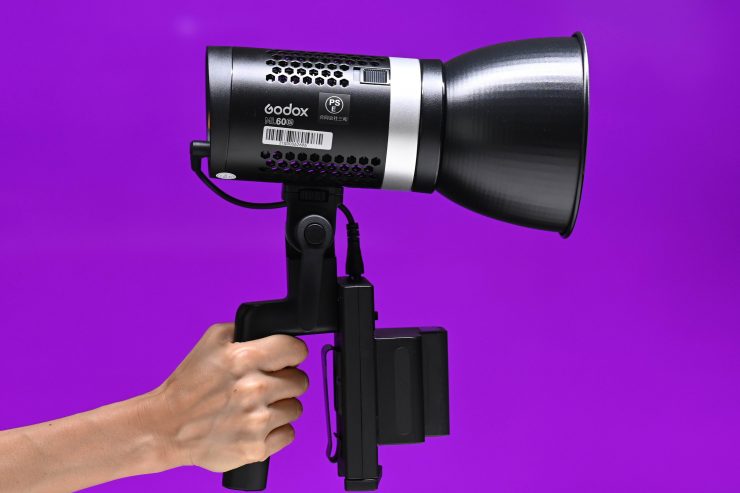
The build quality of the Godox ML 60bi is ok. The housing seems reasonably robust and the attachment grp that you mount the light to tightens down securely.
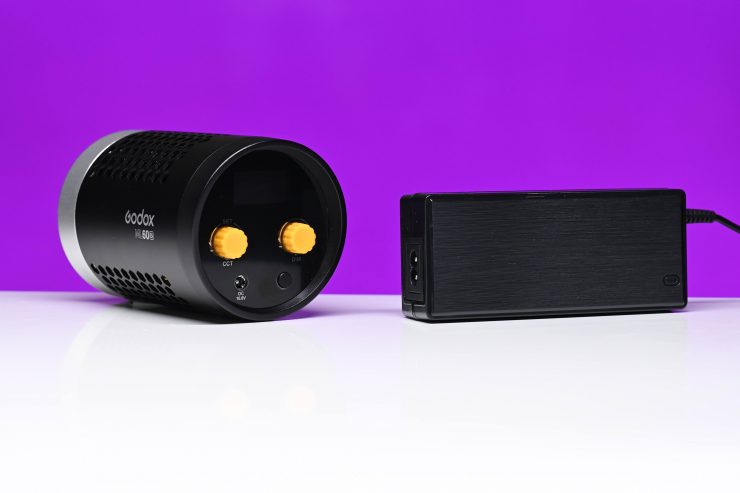
The controller is built into the light fixture, but there is a separate power supply. This is relatively small and Godox has included cables that are of a decent length.
The cable that goes to the power supply is long enough so that you can position your fixture around 180cm / 5.9′ high and still keep the power supply on the ground.
Godox doesn’t give you any way of attaching the power supply to a light stand as there is no hook or lanyard on it like you will find on some other lights.
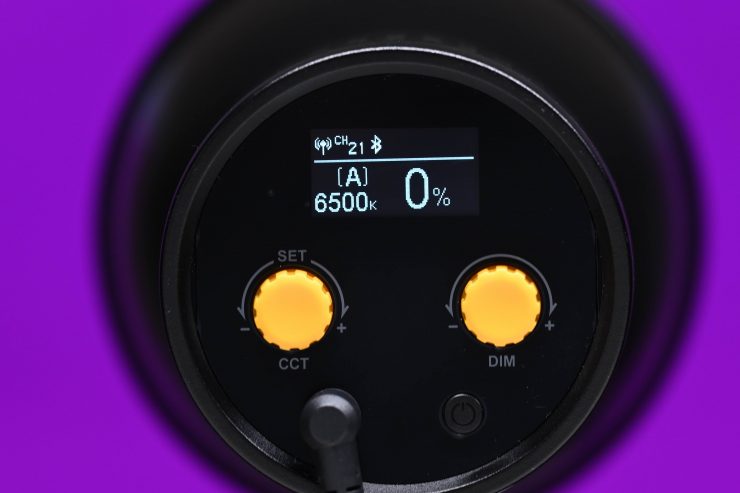
The dials on the fixture are nice and tactile and easy enough to use.
Design
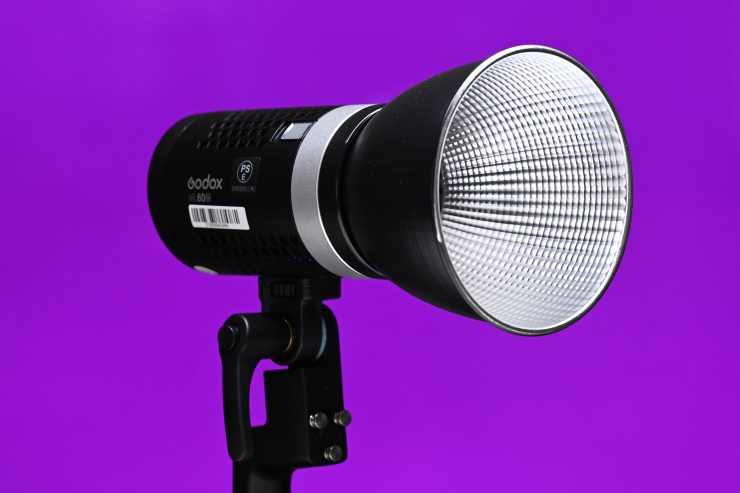
As far as the design goes, it does look a lot like most other COB fixtures. It is essentially a tube with a COB on the front and modifier mount.
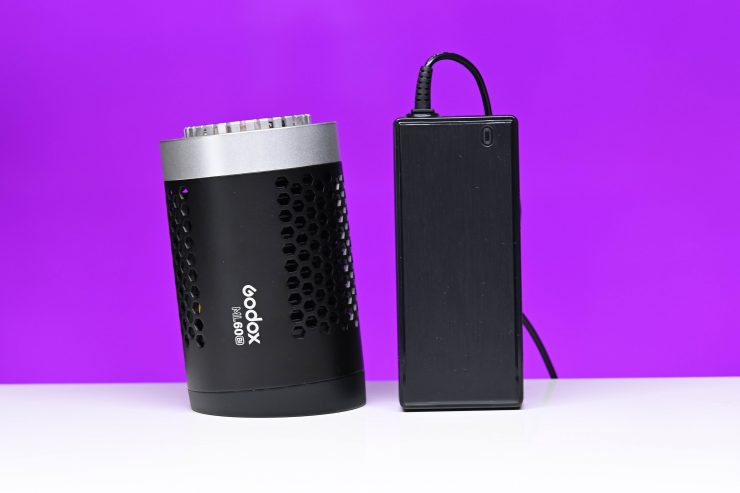
The design consists of the lamp head and a separate power supply. This is fairly common with lights such as these. It is nice not to have a separate controller and have it built into the fixture. This allows you to set up and pack away the light quickly.
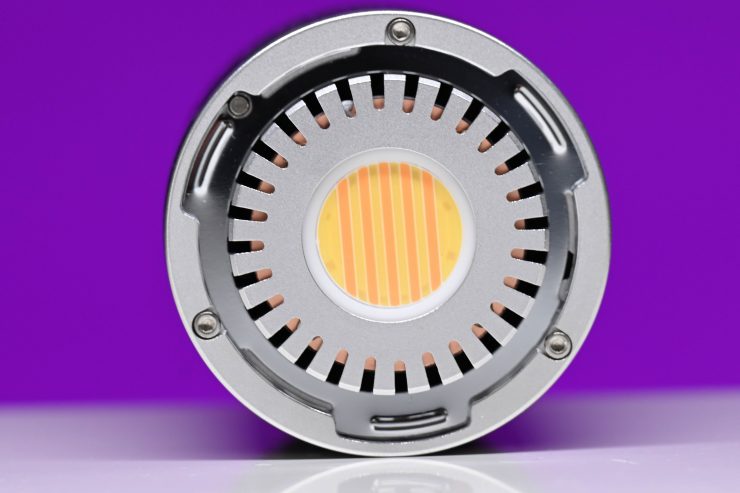
Lots of LED lights on the market, including the Godox ML60bi are using COB technology. COB stands for “Chip On Board” where multiple LED chips are packaged together as one lighting module. The advantage of COB LEDs being multi-chip packaged is that the light-emitting area of a COB LED can contain many times more light sources in the same area that standard LEDs could occupy. This results in a greatly increased lumen output per square inch.
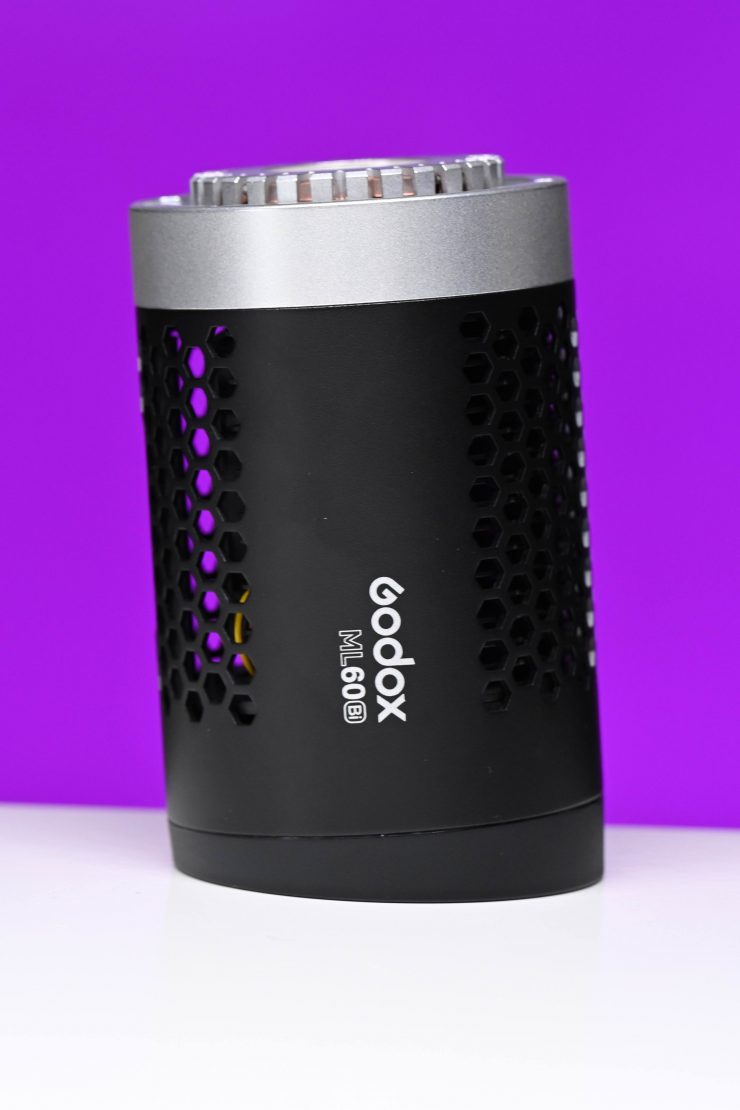
The fixture does feature some type of fan but it is very quiet even when you leave it on at full power for extended periods of time. Although, like the majority of COB lights on the market it does get hot to touch fairly quickly.
The biggest problem with COB LED lights is that unless you diffuse them they are very bright to look at and unsuitable for directly lighting talent. You need to clearly factor this in when judging how much output it has when used with the reflector.
Weight & Size
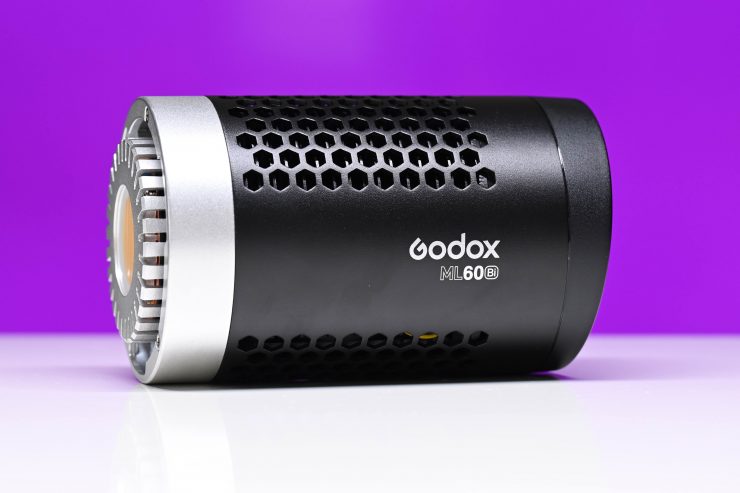
The Godox ML60bi weighs just 770g / 1.69lb (light head only). As I have already mentioned, the controller is built-in to the lamp head, there is just a separate AC adapter. The low weight means you can use it with lightweight light stands.
The fixture has dimensions of just 5.7 x 3.5 x 3.5″ / 14.47 x 8.89 x 8.89cm.
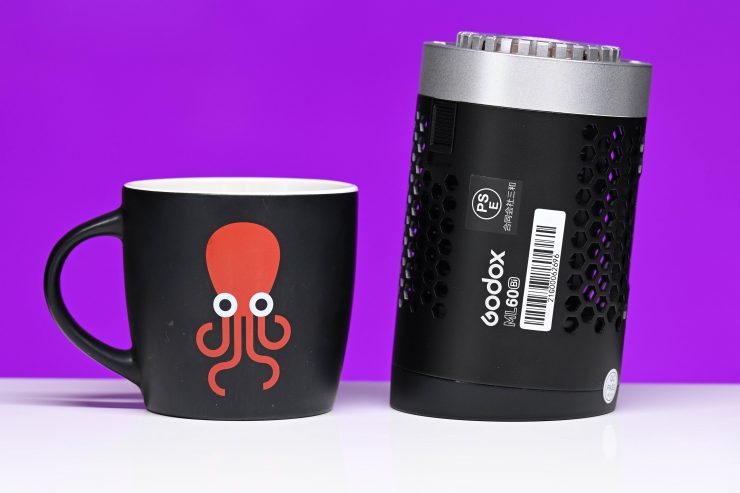
The light itself is very compact. Above you can see its size compared to a regular coffee mug.
Mounting
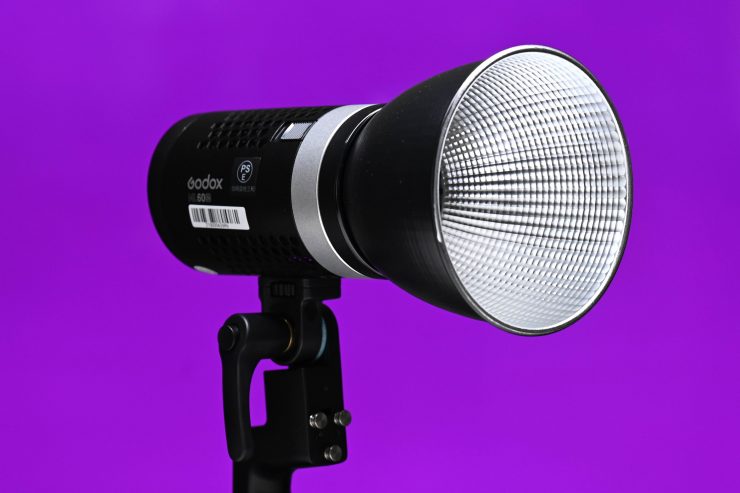
TheML60bi doesn’t come with a yoke frame, instead, you attach it to a mounting grip.
It is fairly quick to attach the light to the mount and secures firmly without any movement.
The only trouble with this type of mount is that the angle of rotation you can get when using the fixture is a little limited. It is even more restricted if you attach the Sony NP battery plate.
If you put large-sized lighting modifiers on the front of the fixture it does become more difficult to lock off the yoke frame adjustment knob.
The mounting grip does have space to insert an umbrella if you wanted to use one.
Power Draw

The ML60bi only draws 60W so it is very easy to run the light remotely for long periods of time using flight safe batteries.
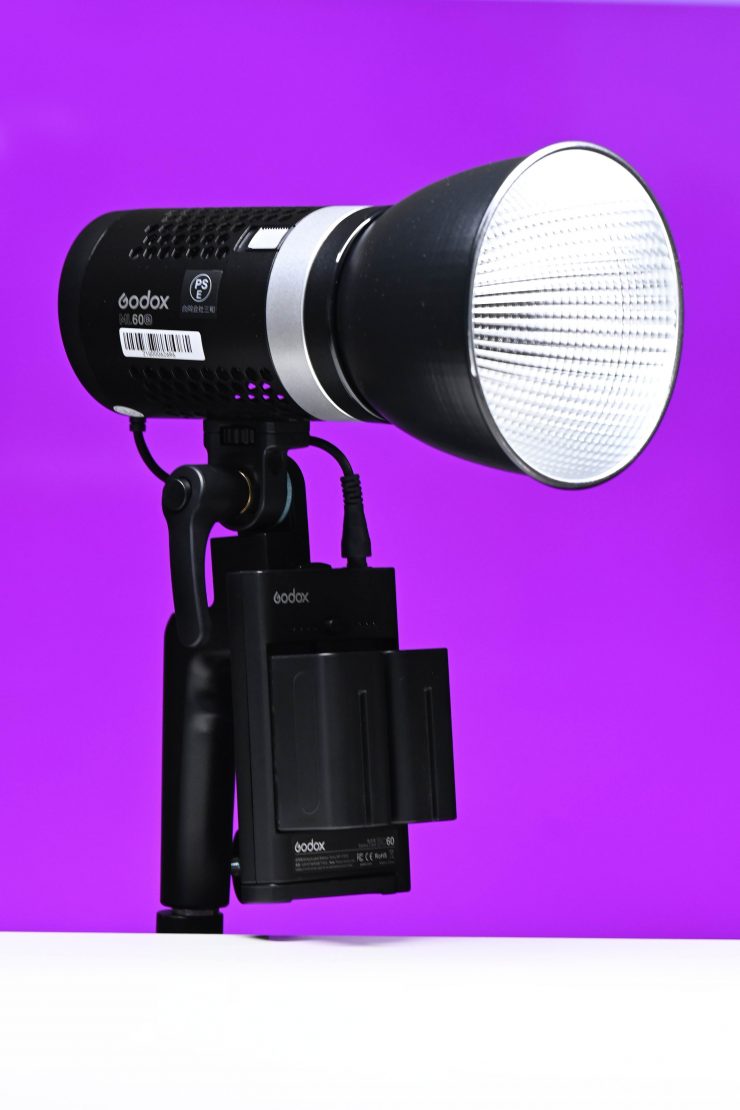
The light can be run off the AC adapter or via two NP-F970 batteries using the included battery plate. Even though Godox states F-970 batteries I found I could still run it off two NP-F750 batteries.
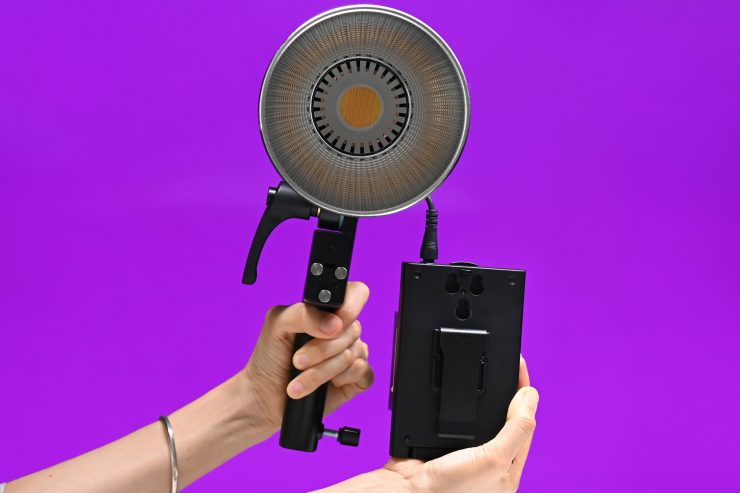
The battery plate attaches to a type of quick-release mechanism. It also has a belt clip on it so somebody could handhold the light and clip the battery plate onto their belt.
Now, the included battery mounting plate is pretty cheaply made and I found that it was very difficult to remove once you put it onto the locking mechanism. It has a plastic release switch that I think could end up breaking over time.
Controls & Menu System
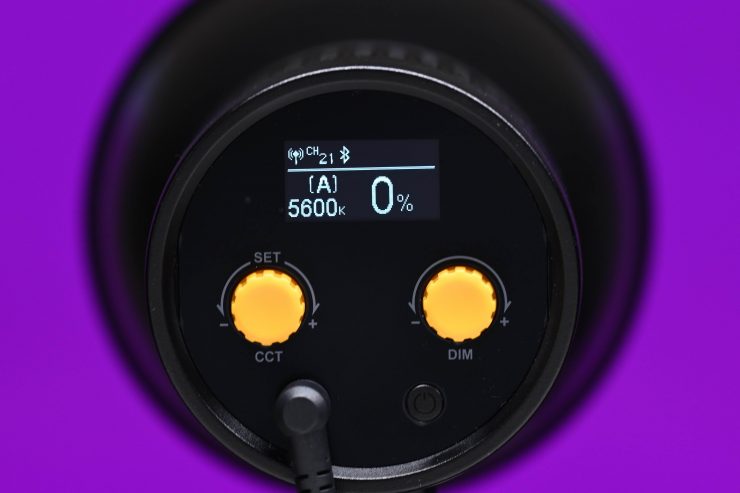
The rear LCD screen is very basic and it just shows you the light’s output intensity as a percentage and the Kelvin color temperature.
With a good light, you shouldn’t have to read a manual to work out how to operate it. You should be able to turn it on and use it straight away. In that respect, the Godox is fairly straightforward and easy to operate.
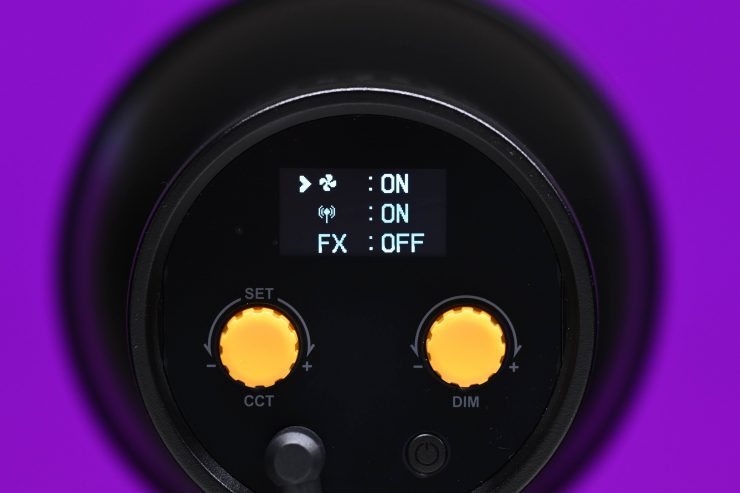
The menu is pretty basic, but you can adjust the fan, DMX channel and group, turn the DMX on/off, and turn the Wifi and Bluetooth on/off, etc.
Bluetooth App
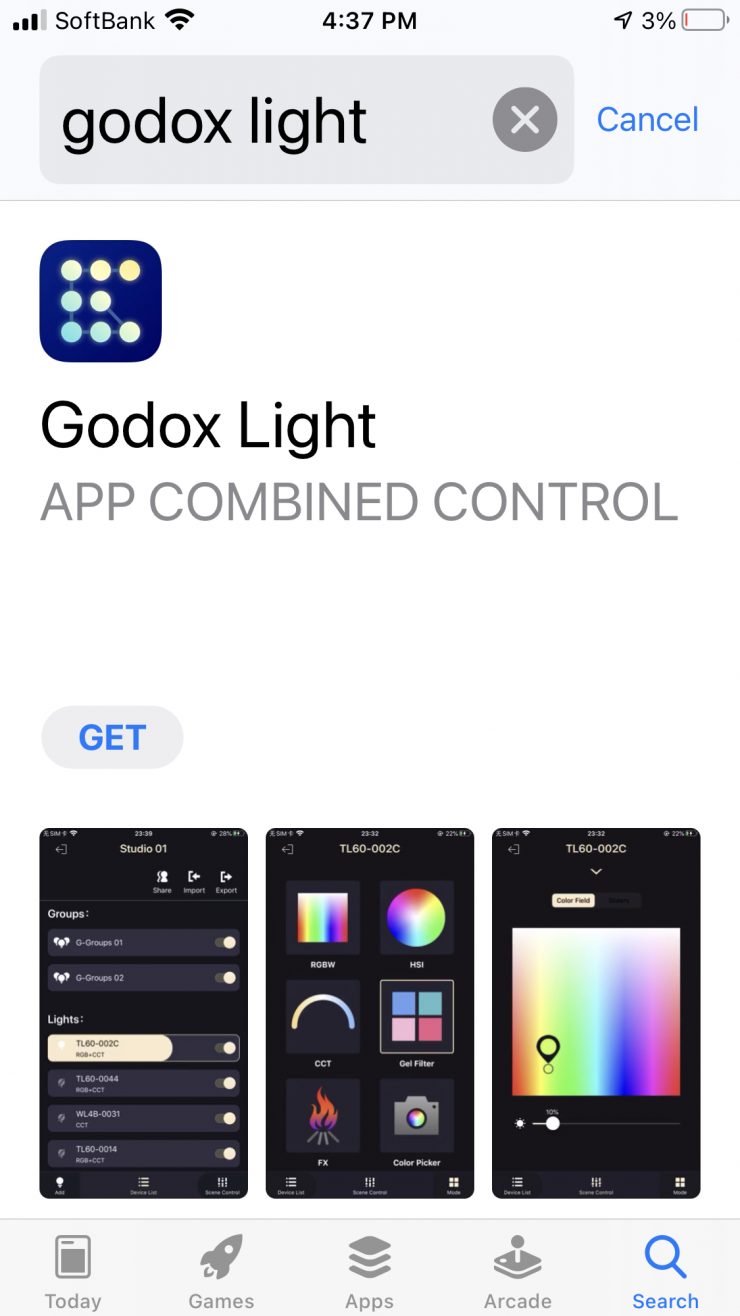
The light can be controlled via Bluetooth using the Godox Light App.
There is a range of parameters that you can adjust using the app.
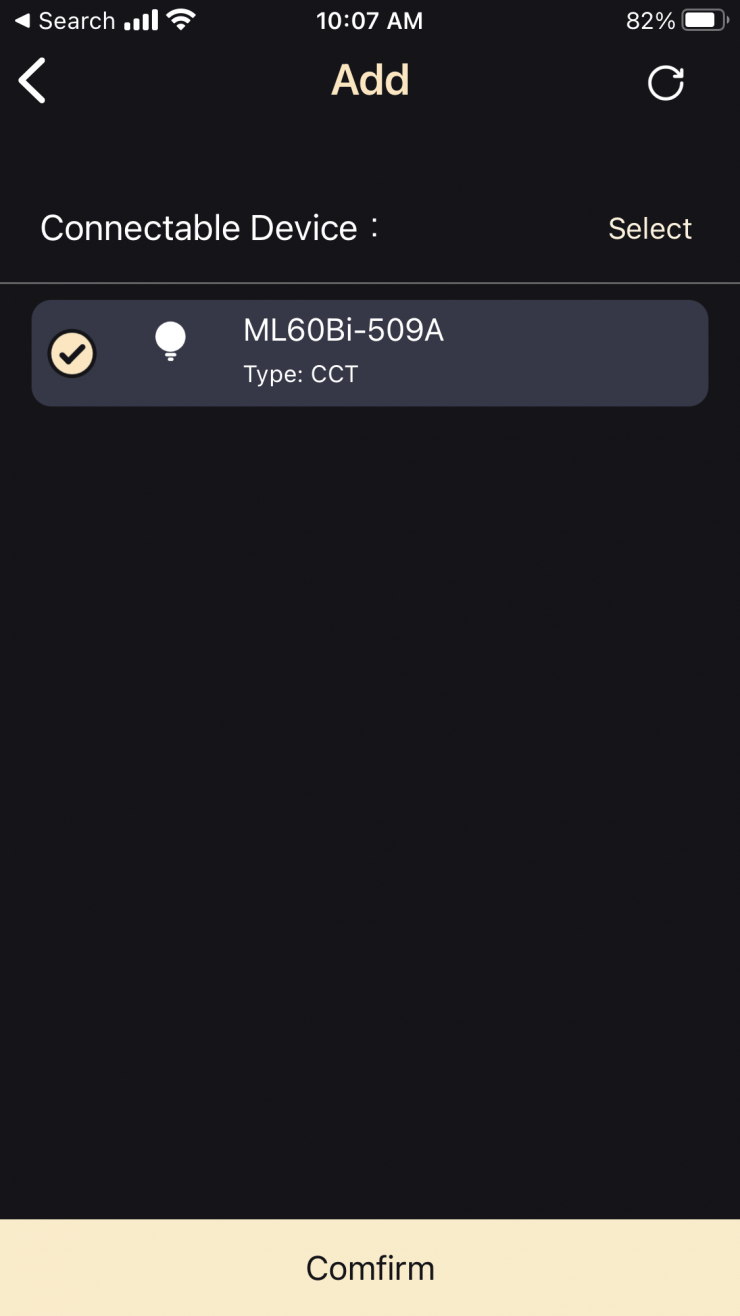
The app is straightforward and easy to use. I like how they have made it intuitive and visually appealing. Lighting control shouldn’t be overly complicated.
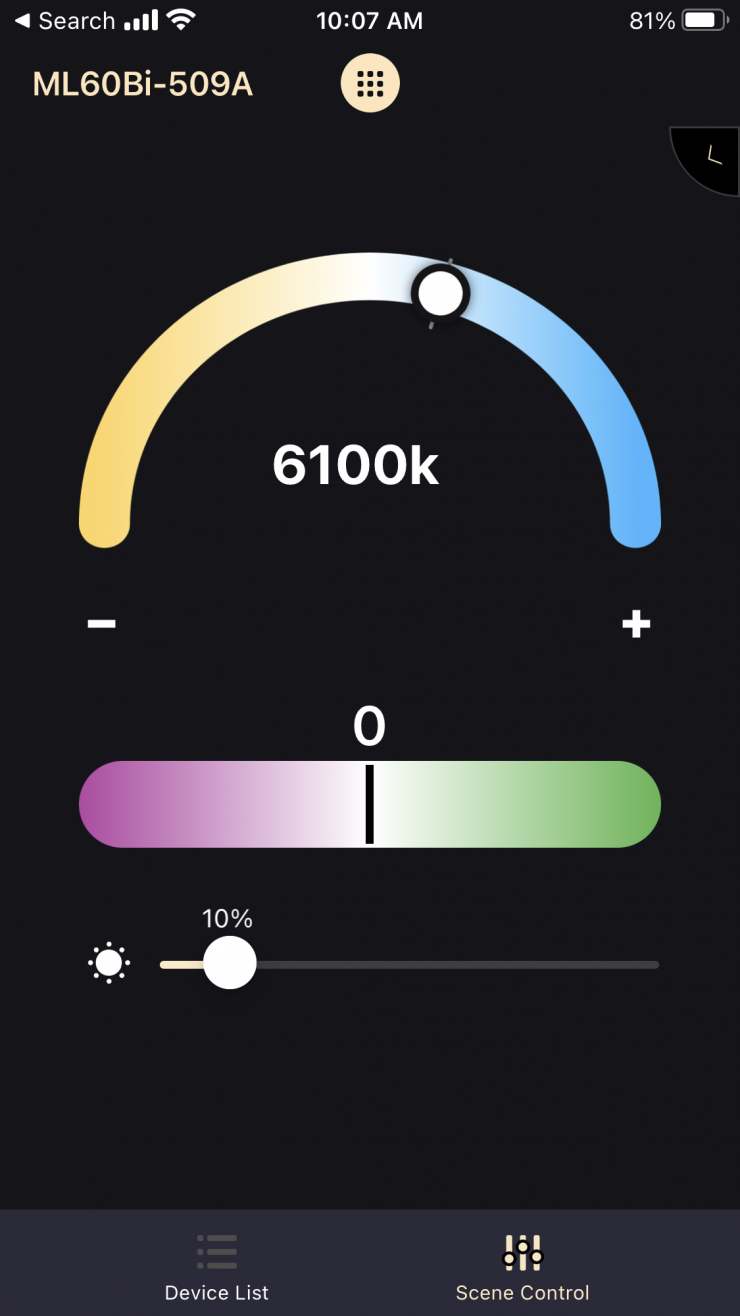
The only slight issue I have with the app is that it hasn’t been optimized for any specific light. For example, even though the ML60bi is only Kelvin color temperature adjustable from 2800-6500K and it doesn’t feature +/- GM adjustment, these items are still shown in the interface.
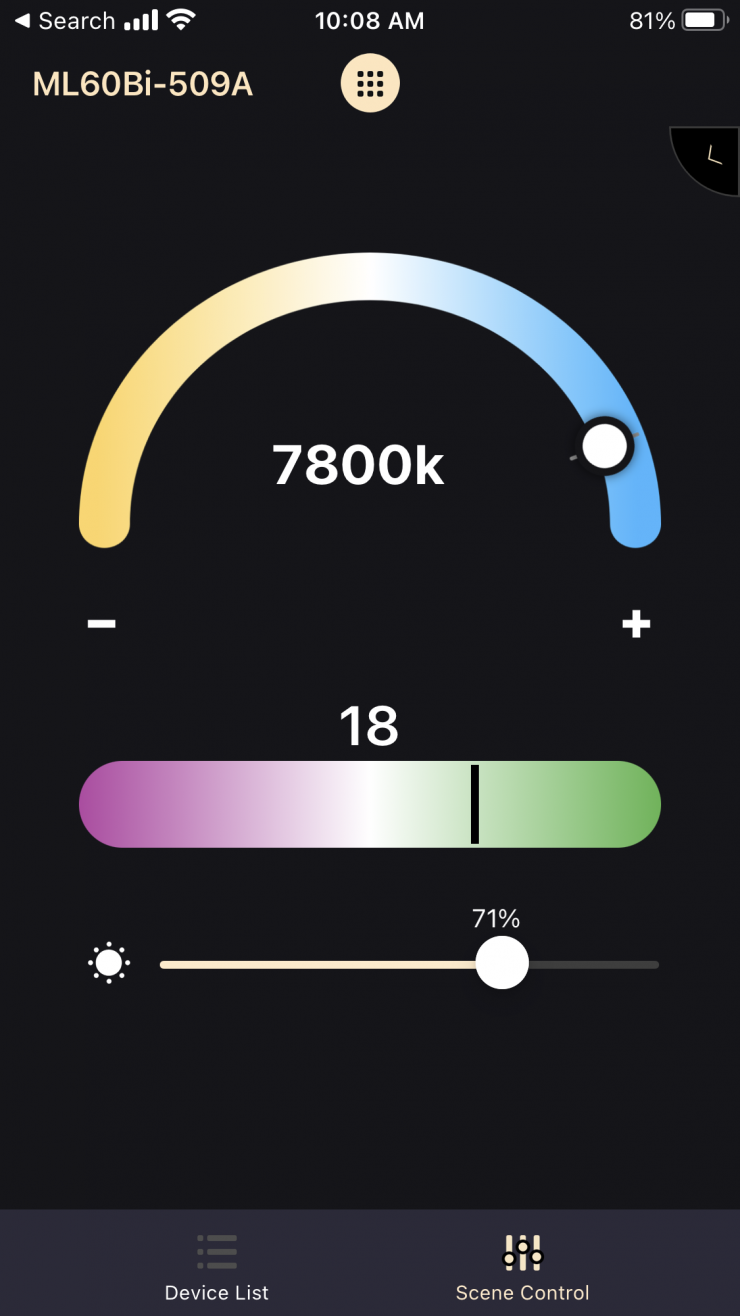
What is even more bizarre is that the app still lets you adjust the Kelvin color temperature above 6500K and it lets you adjust +/- GM bias which has zero effect on the ML60bi. This is very confusing.
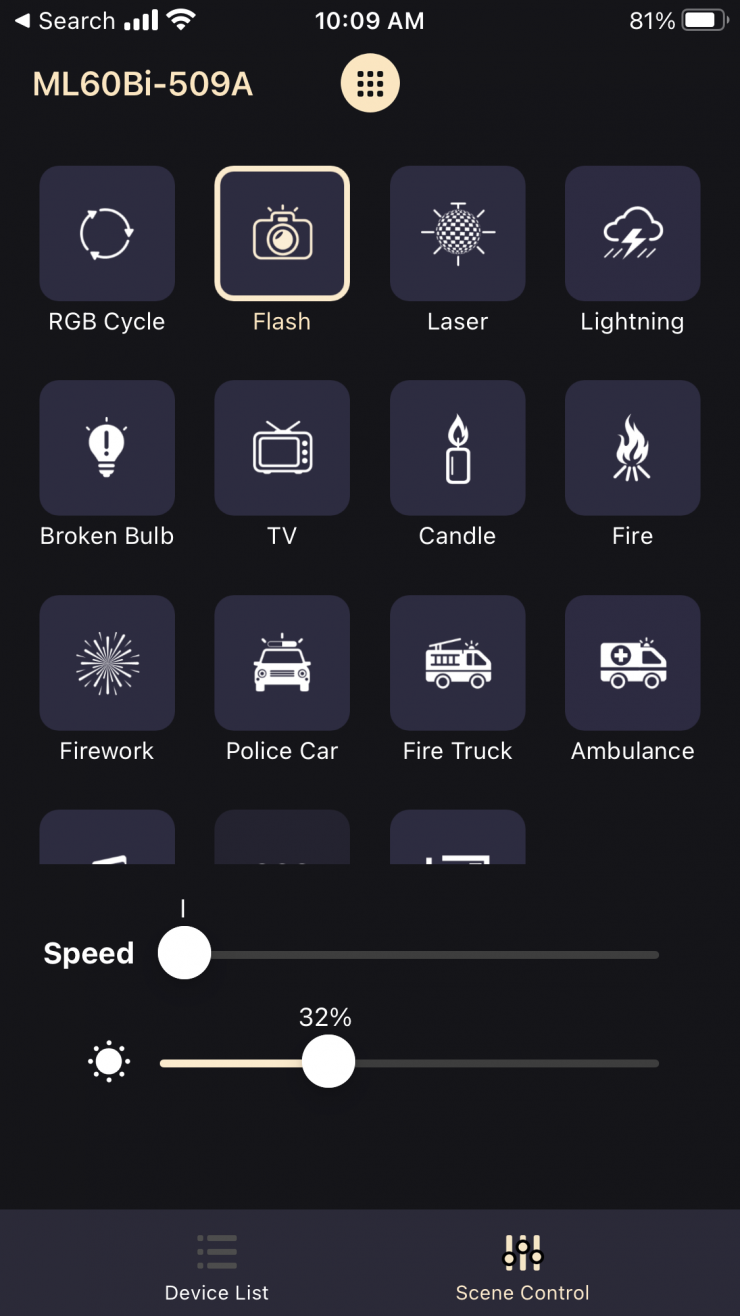
This is also the case when using the FX mode. The app still shows you FX modes that aren’t available on the ML60bi. Godox really should have sorted the app functionality out and tailored it to work with specific lights.
FX
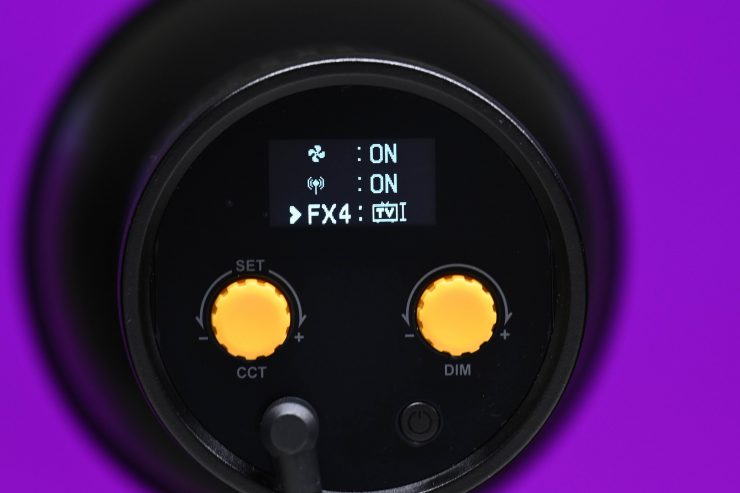
The FX mode lets you recreate 7 lighting effects that can be handy for certain scenarios. The effects are:
- Flash
- Lightning
- Fireworks
- Broken Bulb
- TV
- Candle
- Fire
You can adjust the intensity and the speed of the FX on the light fixture and in the app.
How does it compare to the Nanlite Forza 60B Bi-Color LED Monolight?
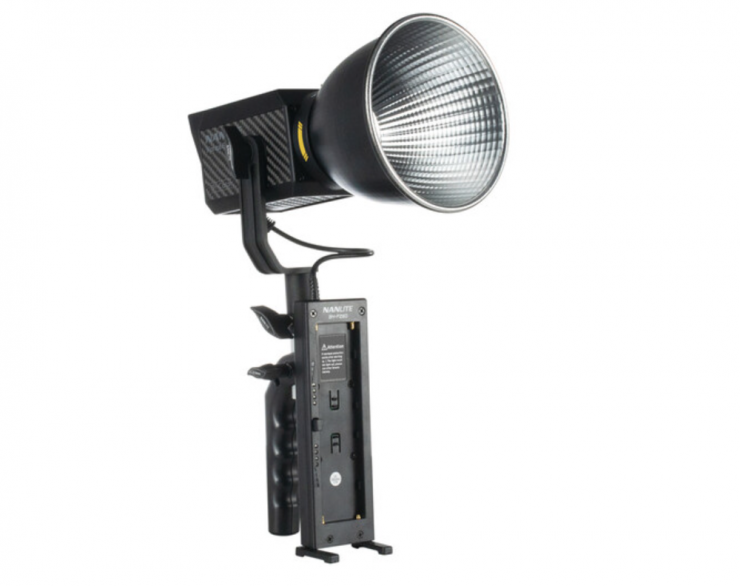
| Godox ML60bi | Nanlite Forza 60B Bi-Color LED Monolight Kit | |
| CCT Range | 2800-6500K | 2700-6500K |
| Effects | Yes | Yes |
| Mount | Godox Mount | Bowens-S Mount |
| Power Draw | 60W | 60W |
| Claimed Output | 10,100lx @1m | 13,830lx @1m |
| App Control | Yes | Yes |
| Battery Plate | Yes | Yes |
| Weight | 770g (lamp head) | 820g (lamp head) |
On paper, both the Godox and the Nanlite are very similar. The Nanlite has slightly more output and it uses a Bowens-S Mount.
How does it stay cool?
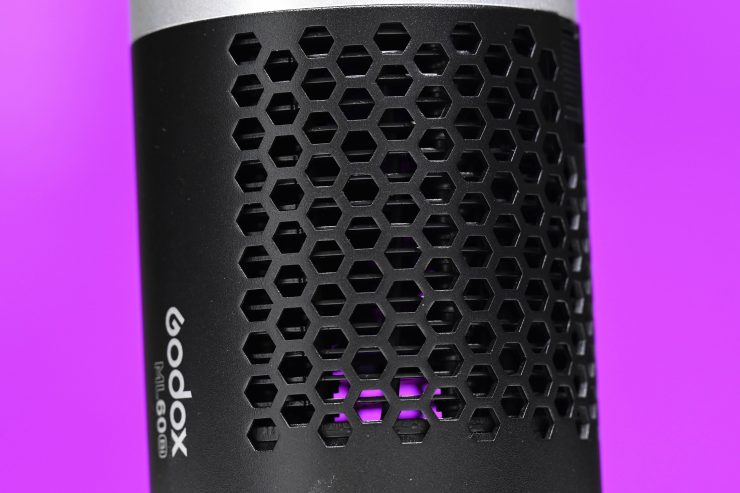
High-powered COB lights get very hot, and keeping them cool is not an easy task. The ML60bi does feature an in-built fan.
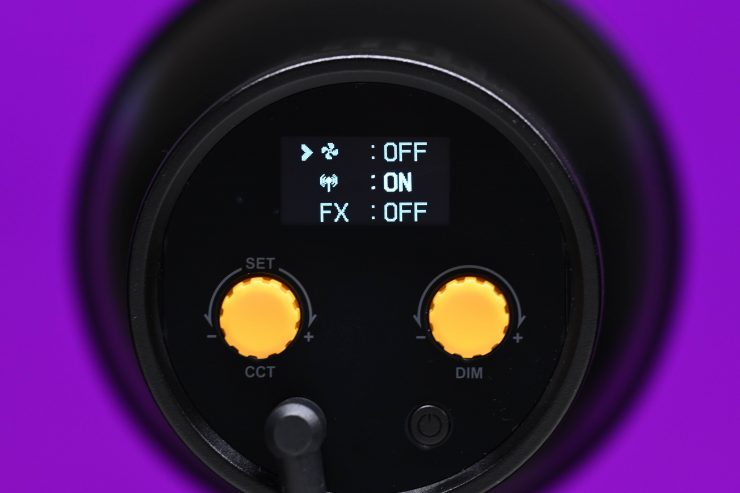
This fan can be turned off, however, the max output then becomes capped at 50%.
The fan in the light is very quiet and I don’t see any real reason why you would need to turn it off.
Photometrics
So now let’s get to the photometric results. I always test lights in this way so that I get a reference to how they compare to other fixtures. Results only tell part of the story and should never be used alone to judge a light. I have found from extensive testing over the years that certain lights that have good photometric results don’t always look good, and lights that have worse photometric scores can sometimes look better than their results indicate.
Different lights can also look different depending on what camera you happen to be using.
It is very important that you don’t judge a light based on one set of tests. You need to look at all of the photometric data to be able to evaluate a light correctly.
Output & Color Temperature Accuracy
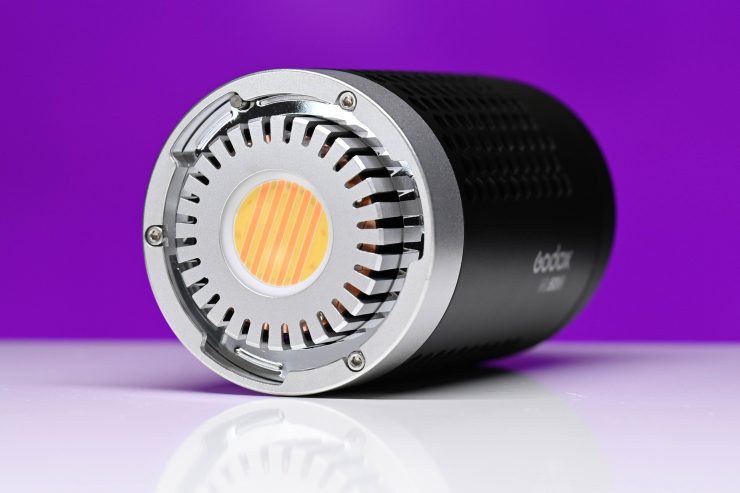
I tested the Godox ML60bi at a variety of Kelvin color temperatures with a Sekonic C-800 Spectrometer to find out how much output the light had and how accurate the Kelvin color temperature reproduction was. All readings are taken at a distance of 1m (3.28ft) in a controlled environment.
Please note that my readings when using the reflector were taken 1m from the edge of the reflector and not the COB.
5600K
5600K (standard reflector 60°)

Above you can see the Godox recorded an output of 11400 lx (1060 fc) when set at 5600K using the standard reflector. This is a good amount of output for a 60W fixture.
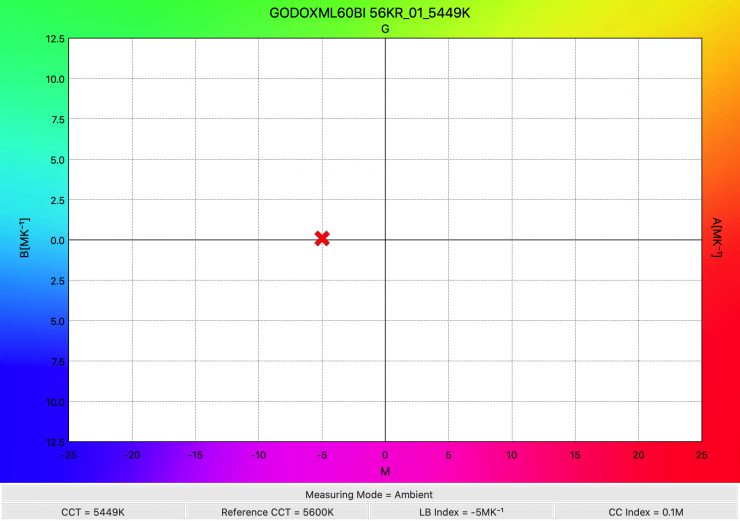
The light recorded a Kelvin color temperature reading of 5449K which was reasonable, but not great.
5600K (standard reflector & battery power)
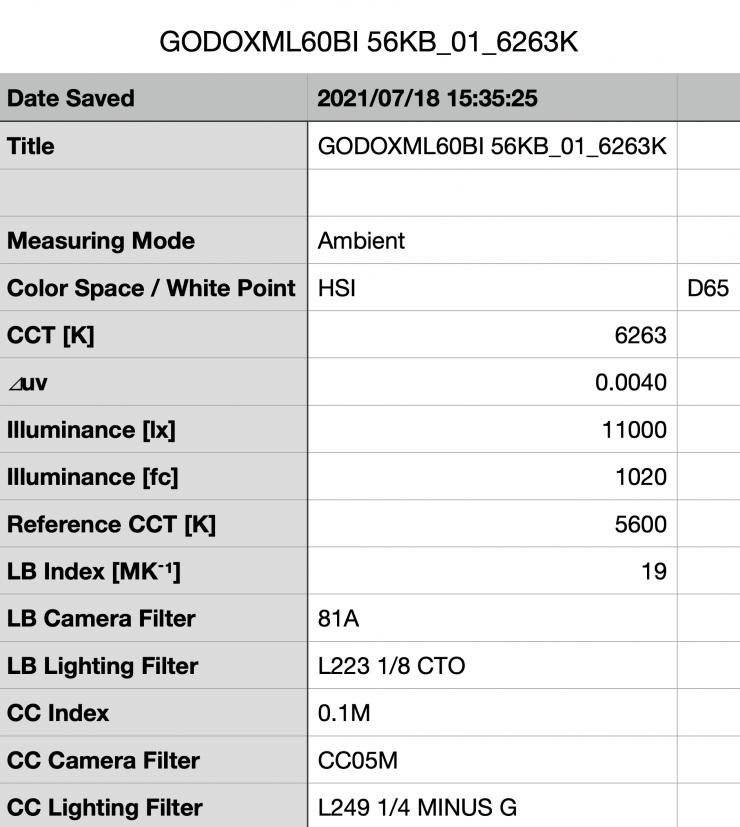
Above you can see the light’s output when it was set at 3200K with the standard reflector and run via battery power was 11000 lx (1020 fc). This was very similar to the output when run from mains power. This shows me that the light is still able to operate at full output when run from batteries.
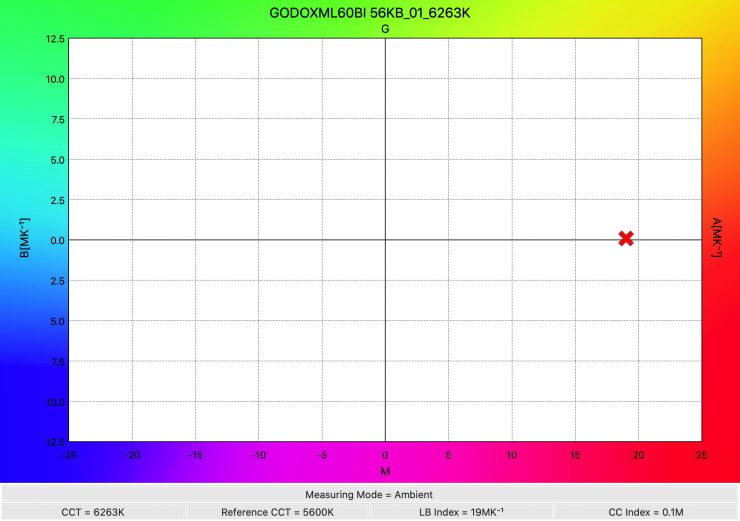
What was a little odd is that when I ran the light via batteries the Kelvin color temperature I recorded was quite different from that when the light was run via mains power. The recorded Kelvin color temperature was more than 800K higher. I have no explanation for why this was the case.
5600K (open face)
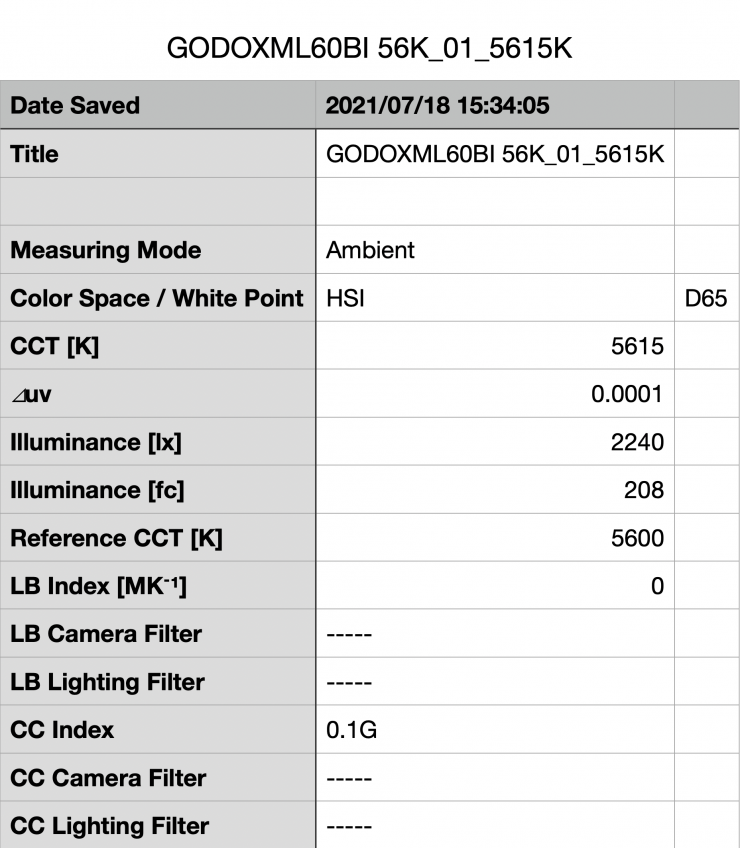
Above you can see the Godox recorded an output of 2240 lx (208 fc) when set at 5600K with no reflector being used.
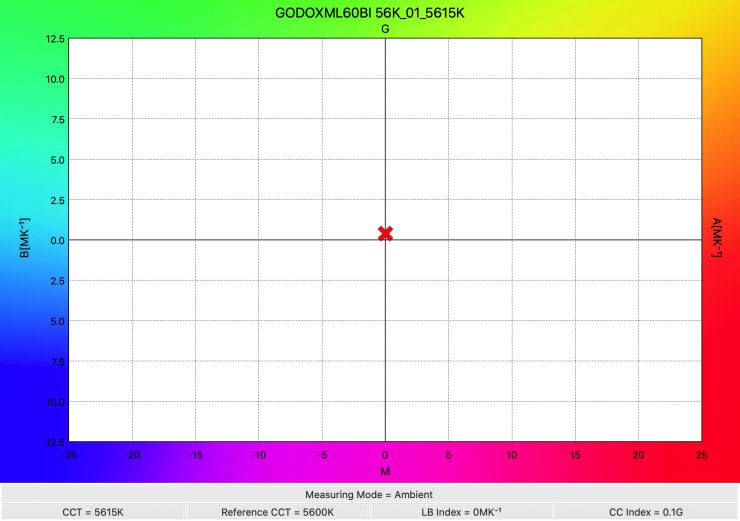
The light recorded a Kelvin color temperature reading of 5615K which was extremely good for a 5600K source light. This shows me that the reflector that comes with the light is altering the Kelvin color temperature slightly. The light is more Kelvin color temperature accurate when used open face.
3200K
3200K (standard reflector 60°)
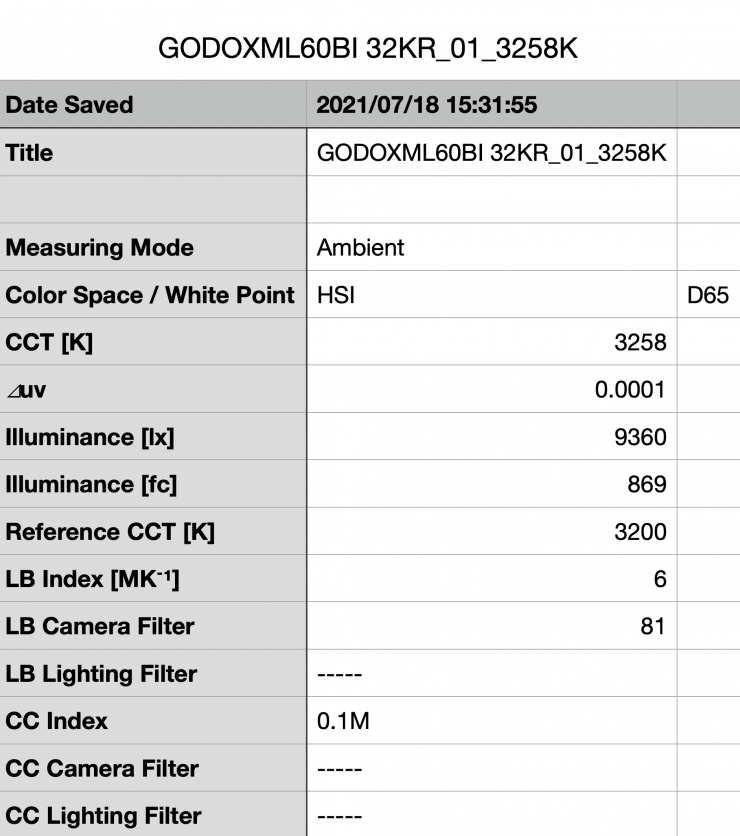
Above you can see the light’s output when it was set at 3200K with the standard reflector was 9360 lx (869 fc), this was 17.9% less than what it produced at 5600K.
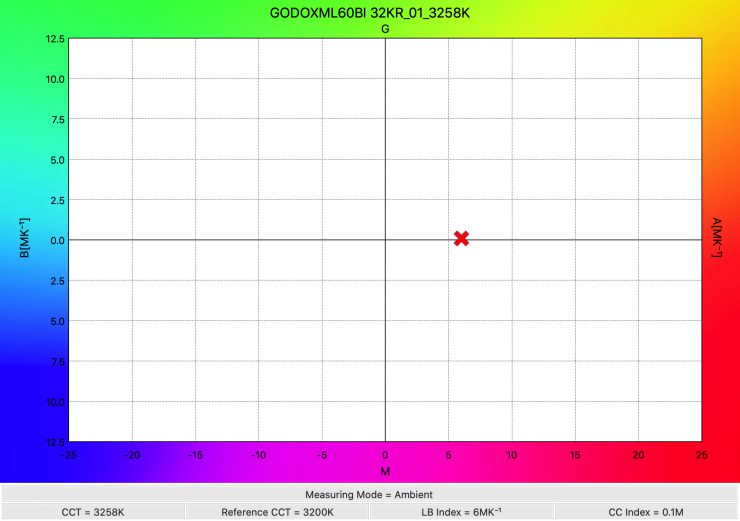
As far as Kelvin color temperature accuracy goes, it recorded a reasonably accurate reading of 3258K. The light is a lot more accurate at producing a 3200K source than a 5600K source when using the reflector
3200K (standard reflector & battery power)
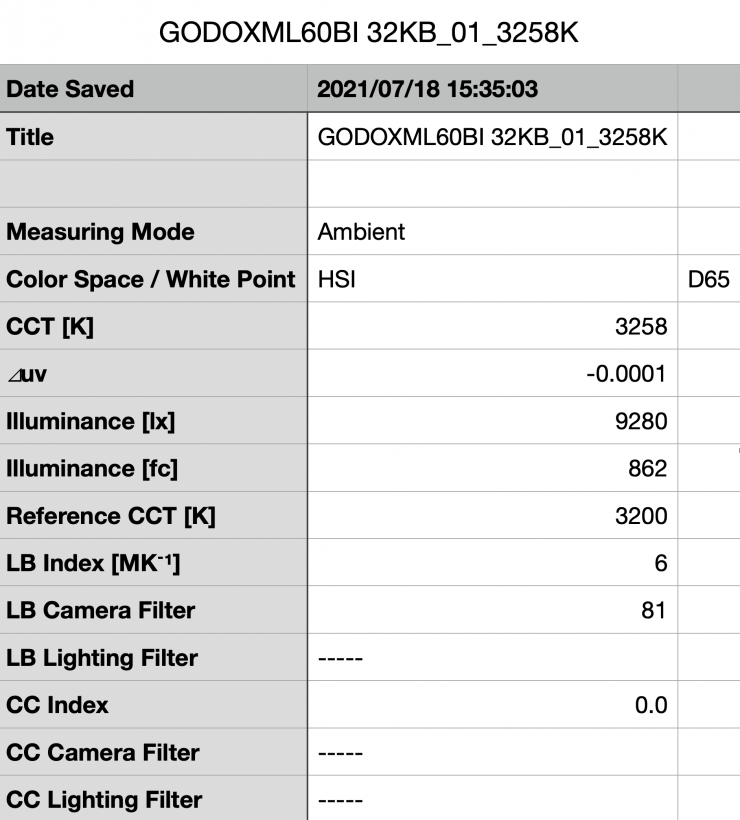
Above you can see the light’s output when it was set at 3200K with the standard reflector and run via battery power was 9280 lx (862 fc). This was very similar to the output when run from mains power. This shows me that the light is still able to operate at full output when run from batteries.
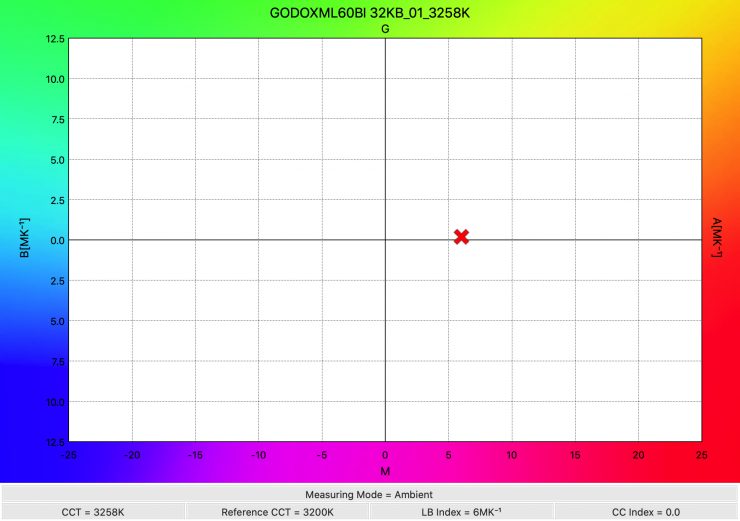
The light recorded a Kelvin color temperature of 3258K which was identical to what it recorded when run via mains power.
3200K (open face)
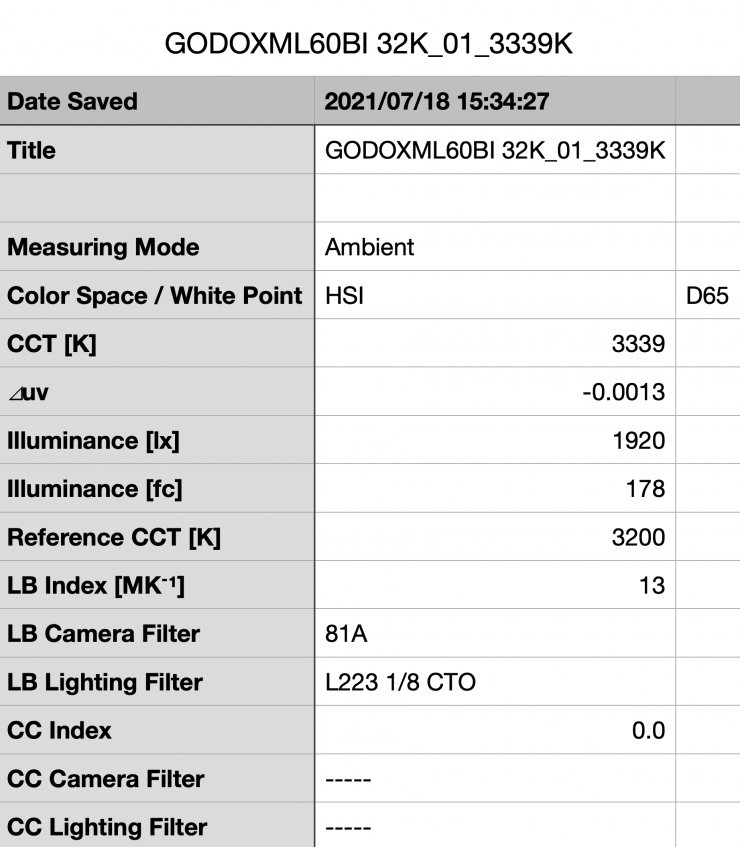
Above you can see the lights output when it was set at 3200K and used open face. It produced 1920 lx (178 fc), which was 14.3% less than what it produced in the same configuration at 5600K.
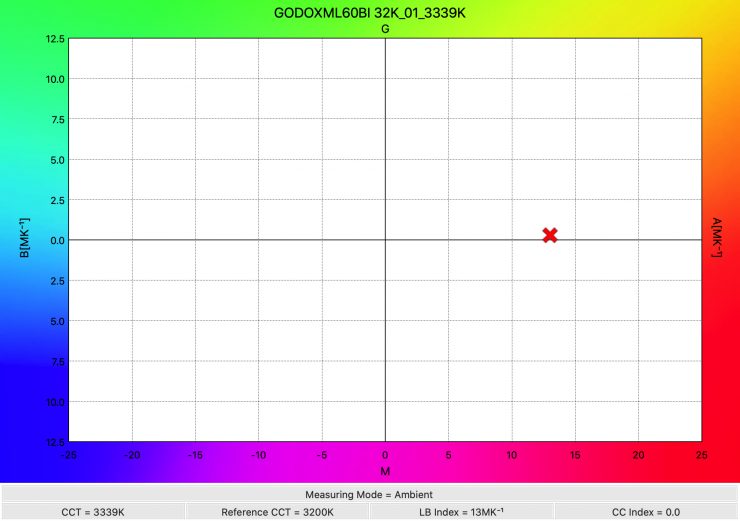
As far as Kelvin color temperature accuracy goes, it recorded a reading of 3339K, which was slightly higher than what it recorded when using the reflector.
How does it perform at various Kelvin color temperatures?
Summary of results
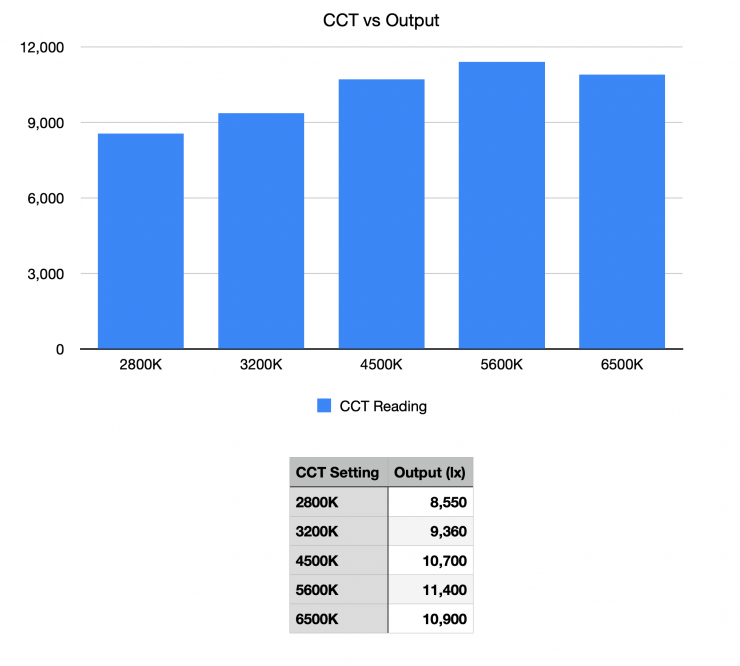
These results show me that the light’s output does vary over its Kelvin color temperature range. It has the most output when used at 5600K and the least amount of output when used at 2800K. The output across the 2800K to 6500K range varies by 25%. From 4500K to 6500K it only varies by 6.1%.
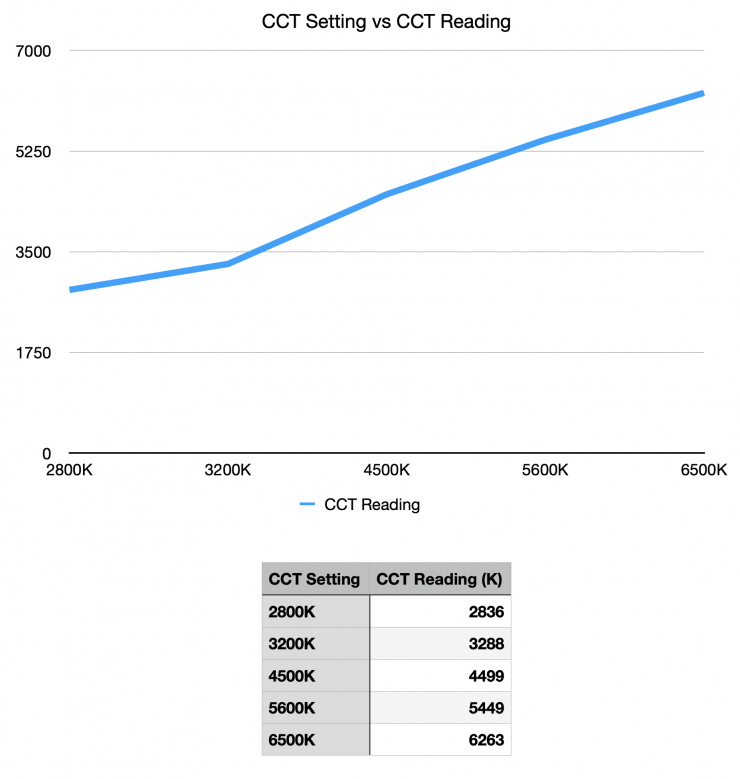
The results also show me that the light is pretty accurate when it comes to Kelvin color temperature reproduction from 2800K to 5600K. At 6500K it wasn’t as accurate. When used at 4500K and 2800K the readings are excellent.
Kelvin color consistency when dimming the light
Now, what you should always do when testing lights is to see if the Kelvin color temperature remains consistent when dimming the light. Just because you set a light at say 5600K, that doesn’t mean that the Kelvin color temperature will remain stable as you start dimming the fixture down.
I decided to do a series of tests at 100%/75%/50%/25%/10% to see if the Kelvin color temperature being recorded changed. This was done at a distance of 1m using a Sekonic C-800.
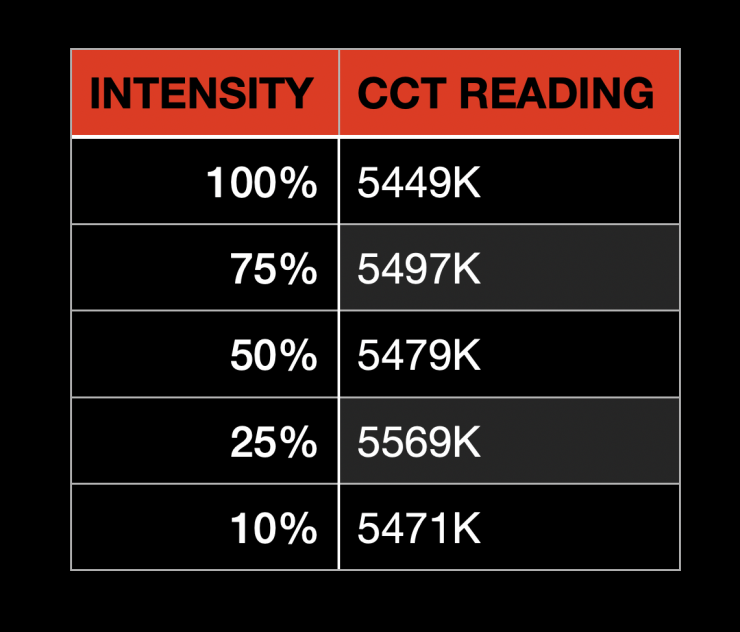
The Godox ML60bi is able to maintain pretty good Kelvin color consistency as you start dimming the fixture. My testing showed that the Kelvin color temperature only varied by 120K. These are good results and it shows me that you can dim this fixture down without having to worry about big changes in Kelvin color temperature.
How linear is the output?
With lights, it is important to check how linear the dimming curve is. So let’s check out how the ML60bi performs.
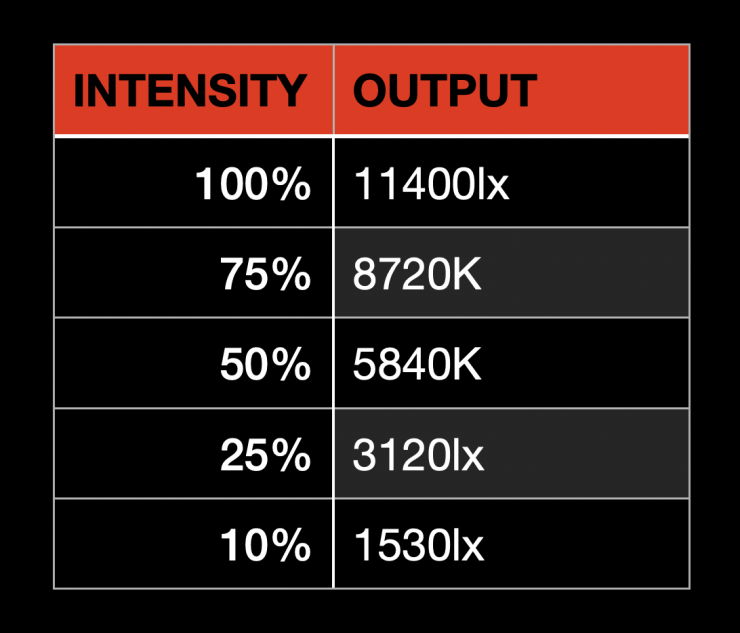
The fixture produces 48.7% less output when used at 50%. At 25% output, it has 72.7% less output. This tells me that the light’s dimming curve is pretty linear.
Color Rendering
5600K (standard reflector 60°)
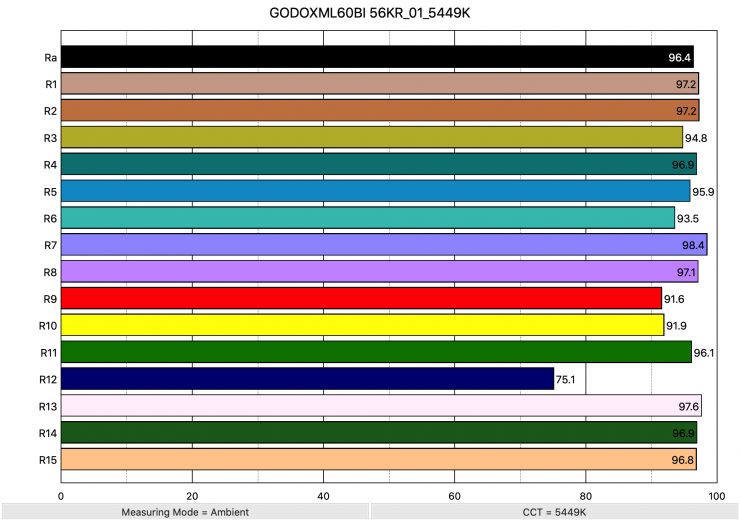
So now that we have seen how much output the Godox ML60bi produces, how does it perform when it comes to replicating accurate colors. Above you can see that when the light was set at 5600K using the standard reflector it recorded an average CRI (R1-R8) of 96.4 and an extended CRI (R1-R15) of 94.46. For replicating accurate skin tones it recorded for R9 91.6 (red), 97.6 for R13 (closest to caucasian skin tones), and 96.8 for R15 (closest to Asian skin tones). These are all very good results.
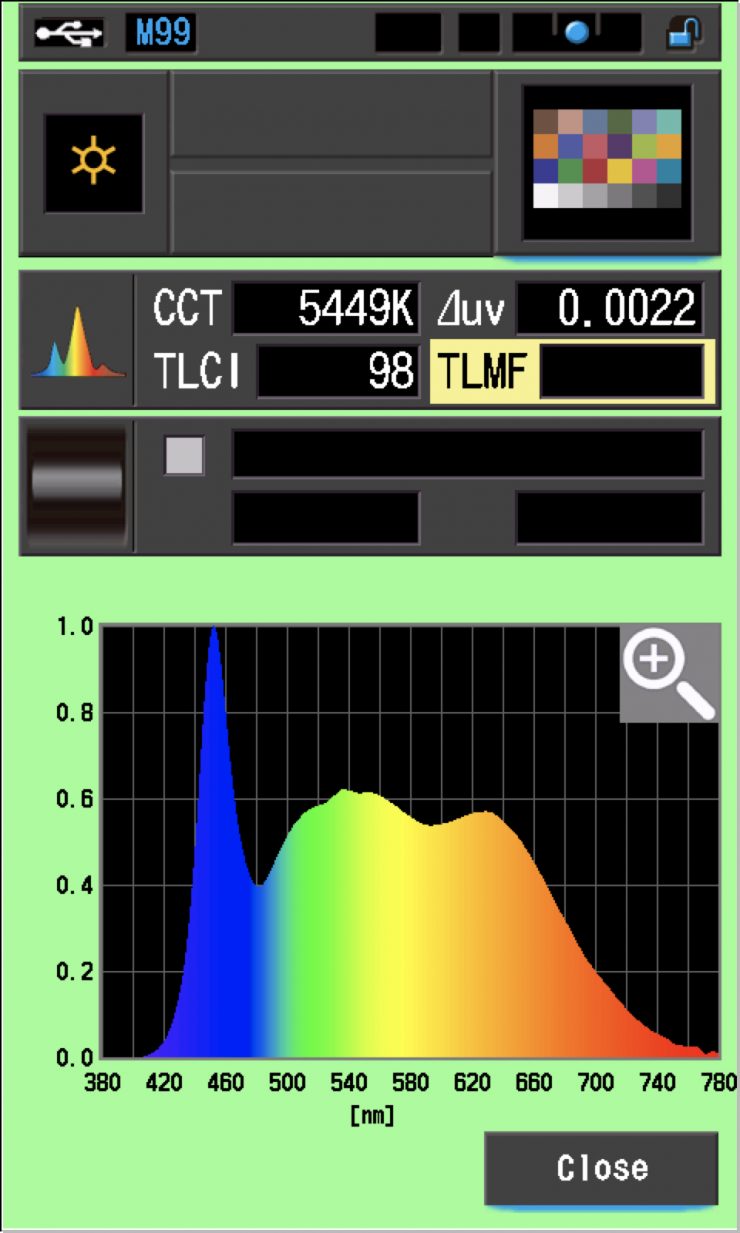
The light, when set at 5600K, recorded a TLCI score of 98.
3200K (standard reflector 60°)
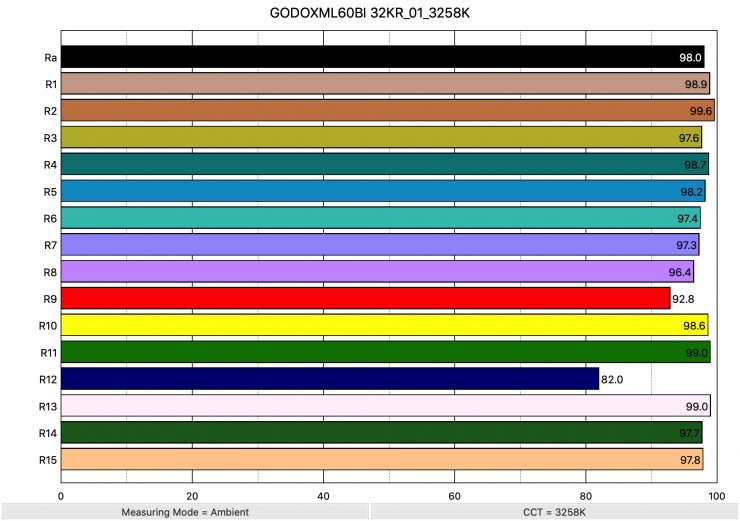
Above you can see the scores for when the light was used at 3200K. It recorded an average CRI (R1-R8) of 98.0 and an extended CRI (R1-R15) of 96.73. For replicating accurate skin tones it recorded 92.8 for R9 (red), 99.0 for R13 (closest to caucasian skin tones), and 97.8 for R15 (closest to Asian skin tones).
These results were better than when the light was used at 5600K.
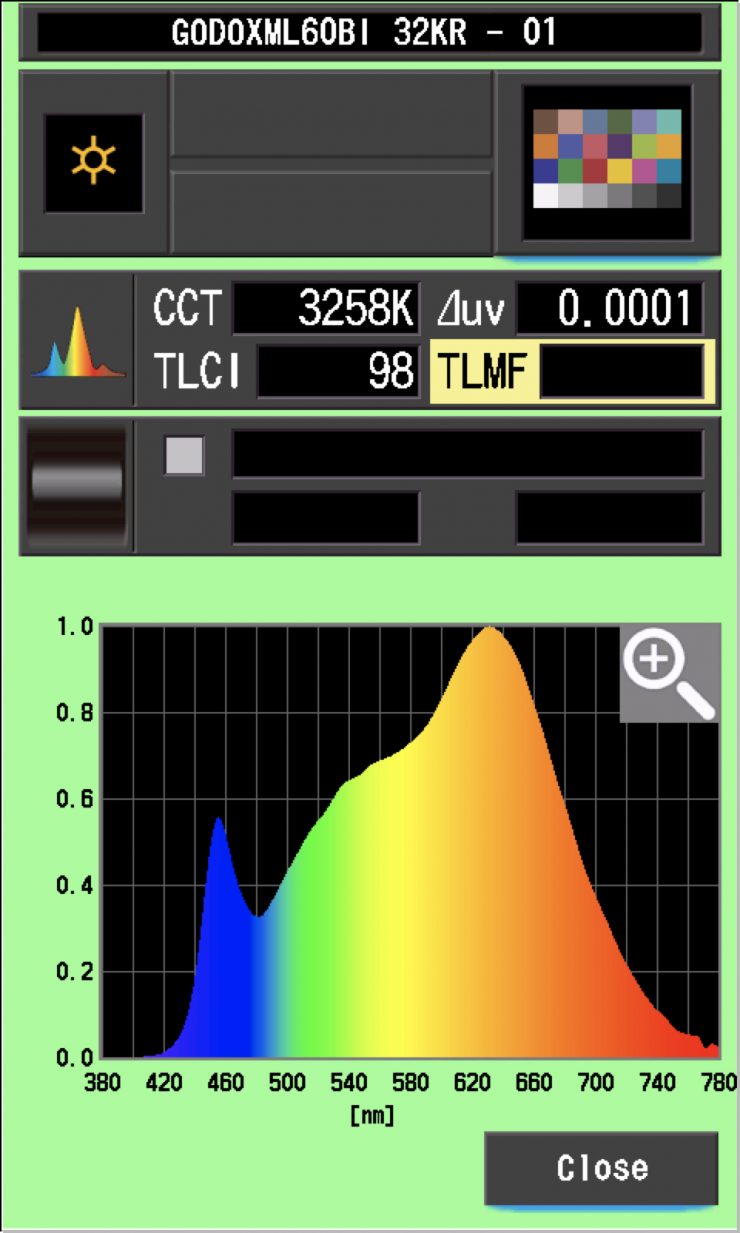
The light, when set at 3200K, recorded a TLCI score of 98.
CC Index & ⊿uv
The CC Index displays the CC correction value and whether any magenta or green need to be added or subtracted. 1 CC corresponds to 035 Kodak CC values or 1/8 Rosco filter values. Any reading less than +1.00 or -1.00 and you’re probably not going to need to make any kind of adjustment. The ⊿uv is the value to show how much this light is away from being an ideal light source (black body radiation = incandescent lamp). As with the CC Index you want this number to theoretically be zero. Kelvin is not a linear value, so we need to convert from Kelvin to MK-1 to compare the values of color temperature. To calculate from Kelvin to Mired is MK-1= 1*1000000/Kelvin. While this may sound confusing, it is the only way of measuring if the Kelvin shift is significant enough to warrant having to use a filter for correction. Below are the results for the Godox ML60bi:
Kelvin Vs MK-1
| Kelvin | Difference in K | MK-1 | Difference in MK-1 | |
| SET VALUE | 2800K | 0 | 357.14 | 0 |
| ACTUAL READING | 2836K | 36 | 352.60 | -4.54 MK-1 |
| SET VALUE | 3200K | 0 | 312.5 | 0 |
| ACTUAL READING | 3258K | 58 | 306.93 | -5.57 MK-1 |
| SET VALUE | 4500K | 0 | 222.22 | 0 |
| ACTUAL READING | 4499K | 1 | 225.27 | 0.05 MK-1 |
| SET VALUE | 5600K | 0 | 178.57 | 0 |
| ACTUAL READING | 5449K | 151 | 183.51 | -4.94 MK-1 |
| SET VALUE | 6500K | 0 | 153.84 | 0 |
| ACTUAL READING | 6263K | 237 | 159.66 | 5.82 MK-1 |
These figures might look confusing, but what it tells me is that the light is reasonably Kelvin color accurate at all temperatures. Any MK-1 score that is under -9/9 means you wouldn’t have to use any color correction gels. The MK-1 scores for this light were very good. Any score where a light is under -/+ 6 MK-1 is considered to be excellent.
CC INDEX & ⊿uv
| CC INDEX | ⊿uv | |
| 2500K | 0.4M | 0.0033 |
| 3200K | 0.1M | 0.0001 |
| 4500K | 0.0 | -0.0011 |
| 5600K | 0.1M | 0.0022 |
| 6500K | 0.1M | 0.0040 |
The light is very consistent across the board and between 3200-6500K it displays very similar characteristics when it comes to the CC Index. At 4500K the light is as close to perfect for replicating a true 4500K source.
TM-30
TM-30 is a relatively new color rendering standard that was developed to deal with the limitations of CRI. TM-30 looks at 99 individual colors. These 99 colors are categorized into seven groups: nature, skin color, textiles, paints, plastics, printed material, and color systems.
TM-30 scores go from 0 – 100. The higher the score, the more accurate a light is at producing colors. Any TM-30 Rf score in the ’90s is considered to be good. What is interesting and something that you need to be very aware of is that two separate light sources with the exact same CRI scores can render colors very differently. A light with a high CRI rating could have a low TM-30 score. Conversely, a light with a good TM-30 score could have a bad CRI score.
Now, there are two measurements associated with TM-30, Rf and Rg.
- Rf (Color Fidelity)
- Rg (Color Gamut)
With Rf value, ideally, you want a score in the 90’s.
With Rg value, a score below 100 indicates that the light source renders colors with less saturation than the reference source. So ideally you want this score to be above 100.
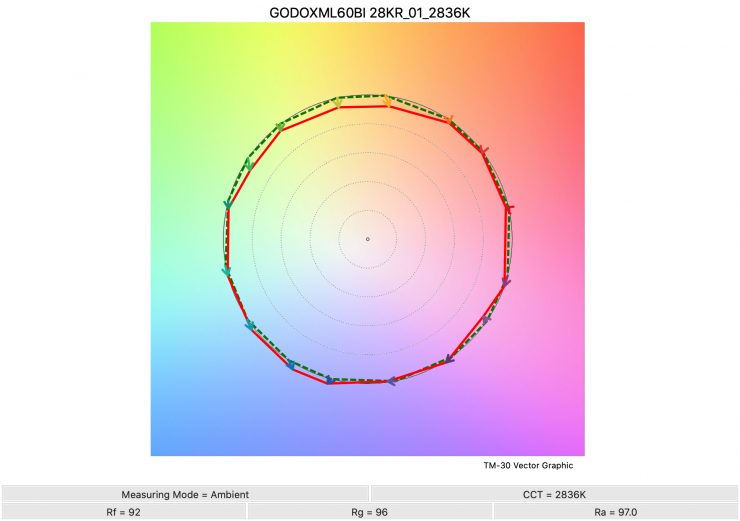

2800K 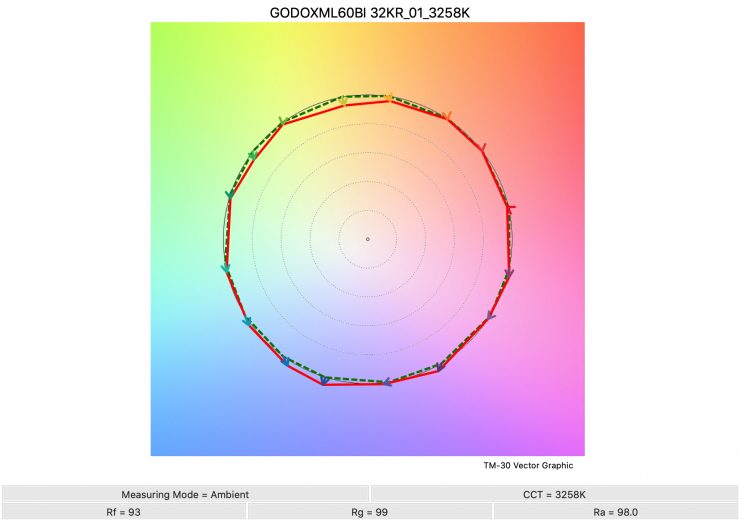
3200K 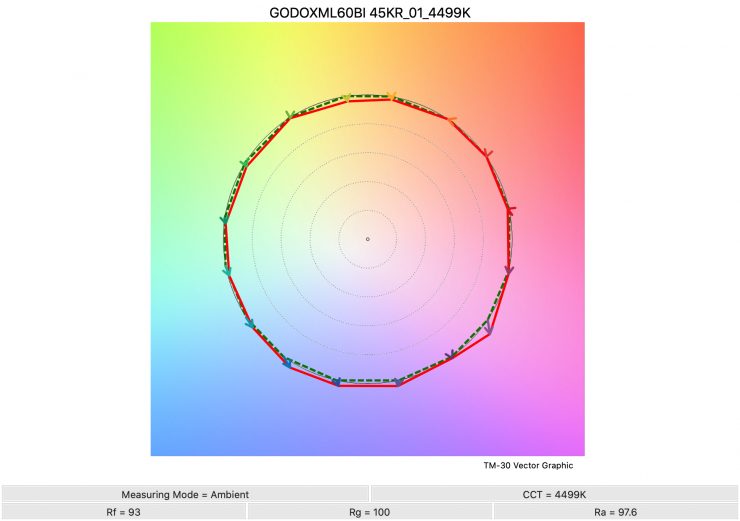
4500K 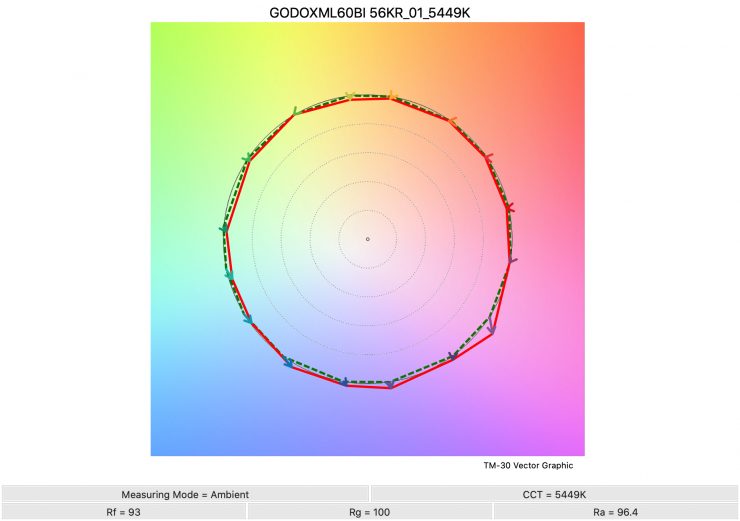
5600K 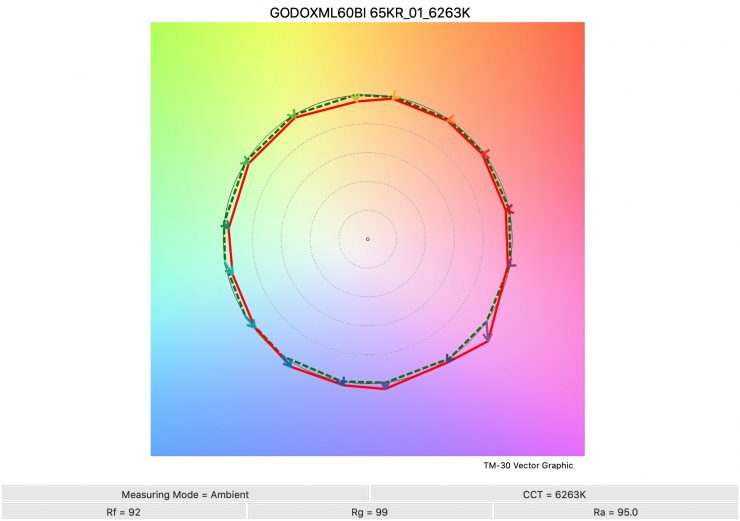
6500K
Above you can see the scores for the Godox ML60bi at various Kelvin color temperatures.
Here are the results:
| Rf | Rg | |
| 2800K | 92 | 96 |
| 3200K | 93 | 99 |
| 4500K | 93 | 100 |
| 5600K | 93 | 100 |
| 6500K | 92 | 99 |
SSI
SSI (Spectral Similarity Index) was developed by the Sci-Tech Council of the Academy. SSI gives me the ability to set any light as a standard, or use predefined standards (such as CIE D55), and then give other lights an SSI score based upon how well they will match standards such as CIE D55. This way I can measure spectral response and compare it directly against an ideal light source. This is actually a much better test than recording CRI scores.
3200K
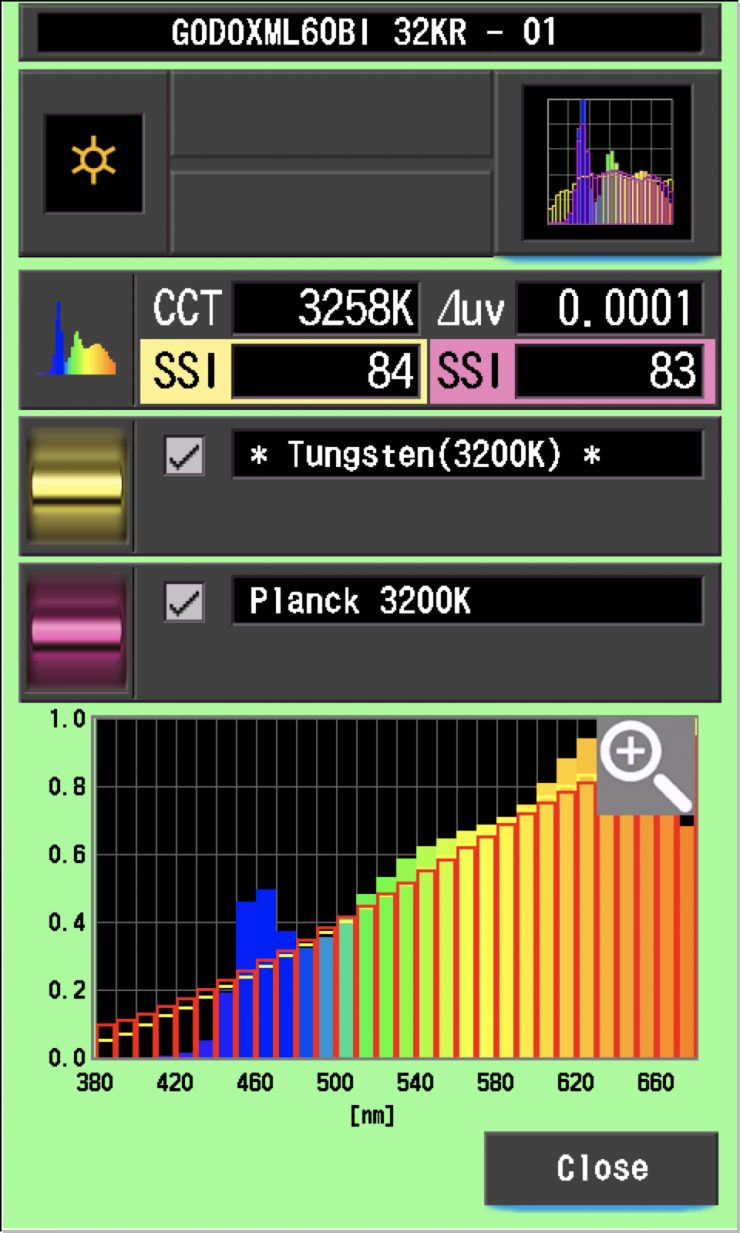
In this graph, the red bars indicate a perfect Planck 3200K source. The gold bars indicate a perfect 3200K Tungsten source. This lets us compare how close to a perfect 3200K lighting source the Godox ML60bi is. Any SSI score in the high 70’s, low ’80s is very good for a 3200K LED light. As you can see, LED lights have a hard time replicating colors below about 450nm.
5600K
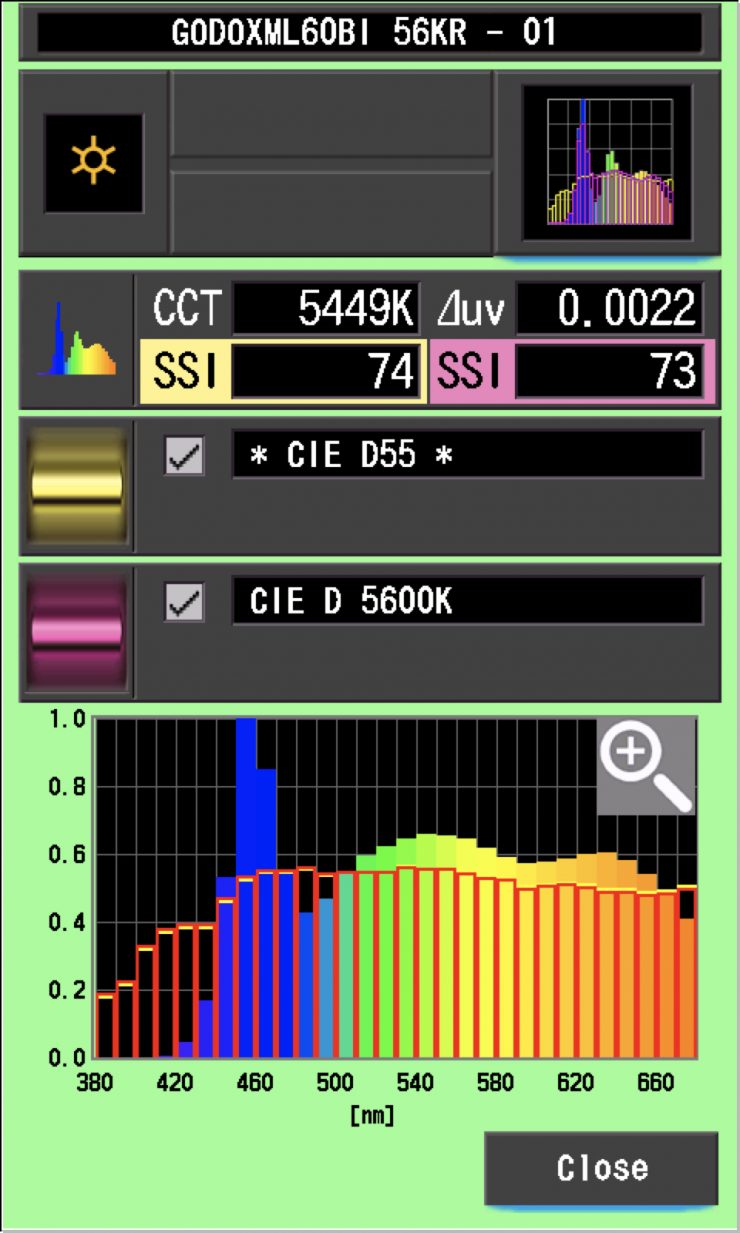
In the graph above the gold bars indicate a perfect CIE D55 source. The red bars indicate a perfect CIE D 5600K source. This lets us compare how close to a perfect 5600K lighting source the Godox ML60bi is. A score in the low 70’s is typical for a 5600K LED source.
The main reason we want to record SSI scores is so we can see how well they match with other lights. As an example, I wanted to see how well the Godox ML60bi matched the Godox SZ150R and the ARRI Orbiter. Below you can see the results.
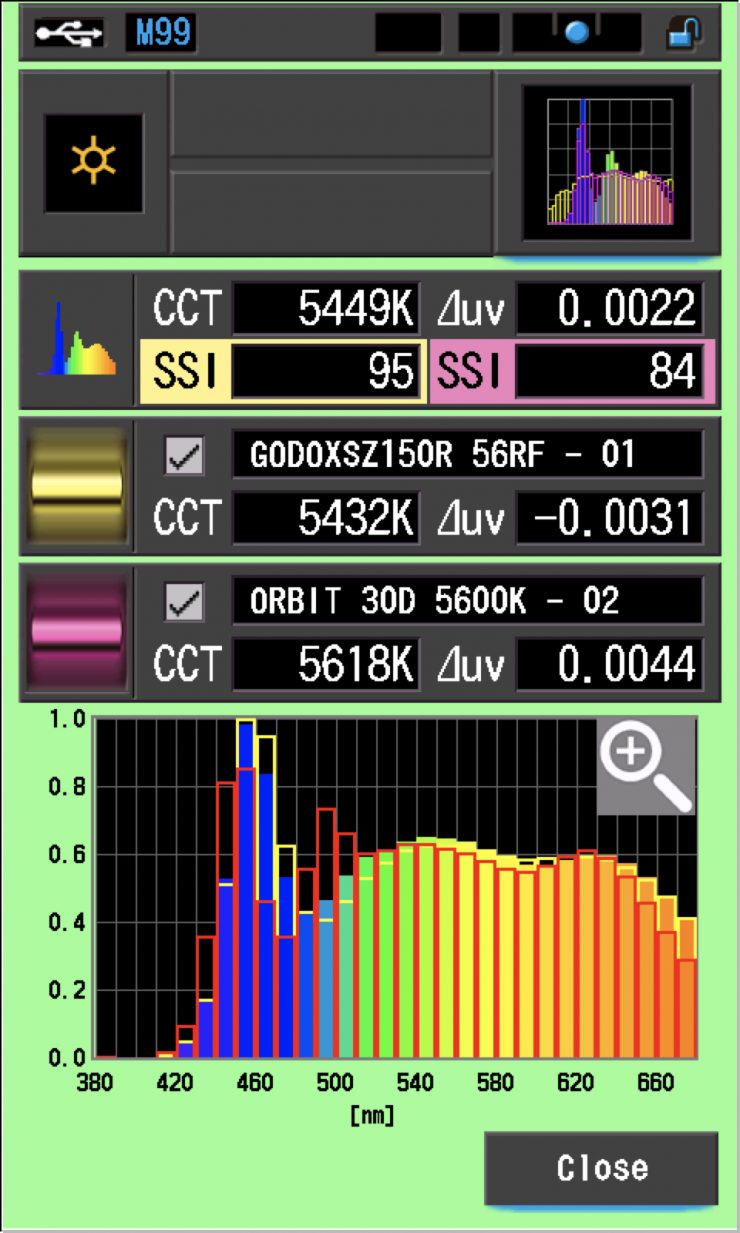
As you can see the ML60bi matches up pretty well to the Godox SZ150R, but not nearly as well with the ARRI Orbiter. This is no big surprise and lights from the same manufacturer, especially the similar style of lights, tend to all match fairly well.
So, what about if we use the light at 3290K. Let’s go ahead and pick two other lights we have previously reviewed to see how well they match. For this example, we will compare the Pilotfly RX50P and the Prolycht Orion 300 FS.
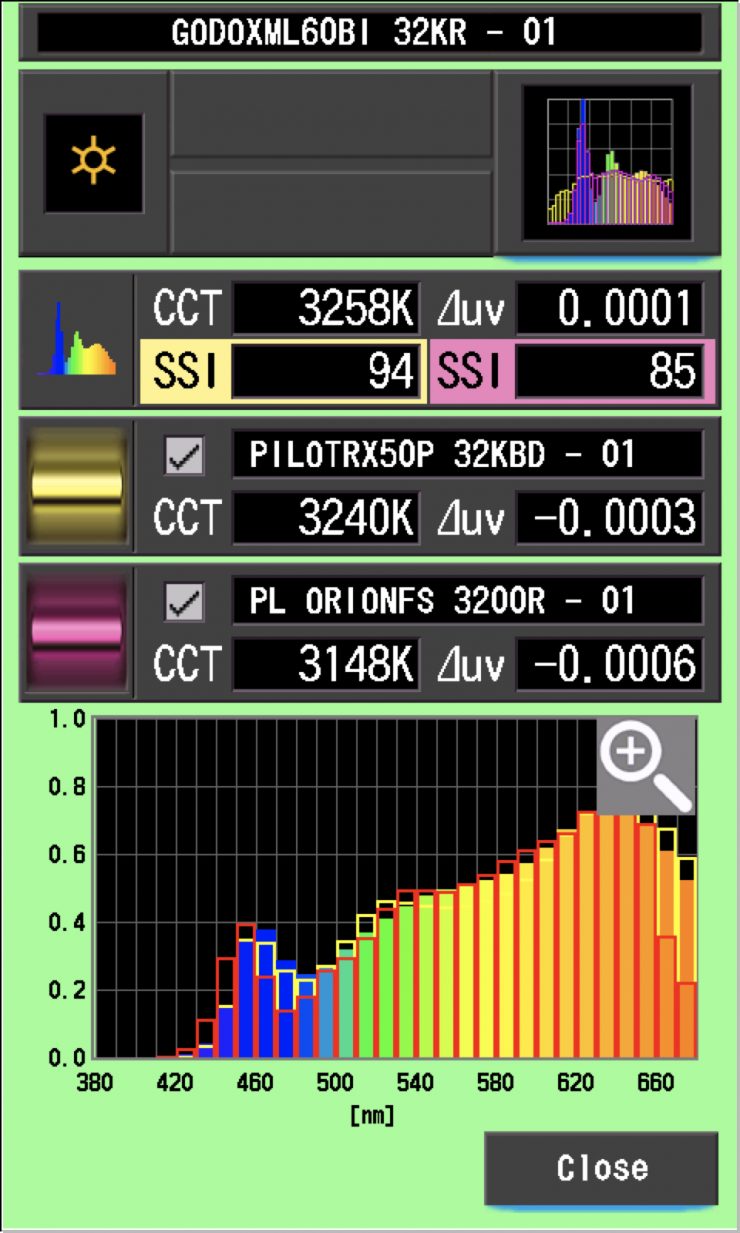
AS you can see, the Godox ML60bi matches well with the Pilotfly RX50P, but not as well with the Prolycht Orion 300 FS.
SSI tests are a great way of telling you what lights you own or use will work well together.
Spectral Distribution
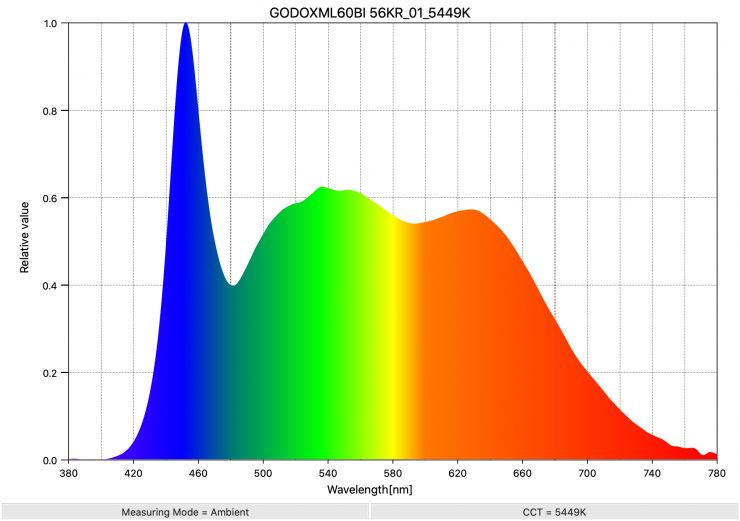
Above you can see the spectral distribution of the Godox ML60bi when it is set at 5600K. The spectral distribution is reasonably good and there aren’t any big spikes where there shouldn’t be.
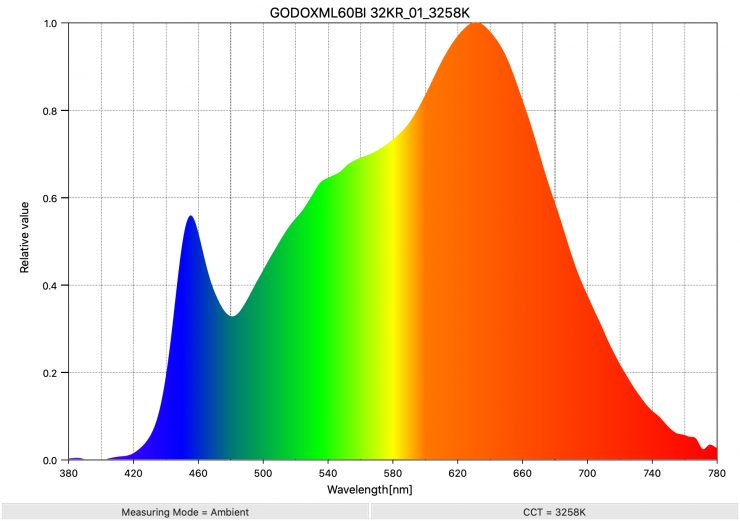
Above you can see the spectral distribution of the Godox when it is set at 3200K. Again, just like at 5600K, the spectral distribution is pretty good.
Accessories
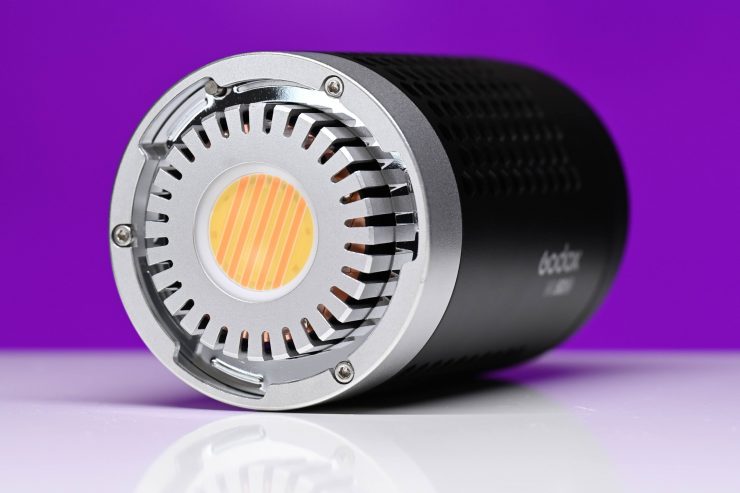
Here lays the biggest issue with this light. It doesn’t use a Bowens mount, it is a proprietary Godox mount. This limits the number of lighting modifiers you can use.
You can use the AD-S60S/AD-65S/AD-S85S Softbox with this Godox mount.
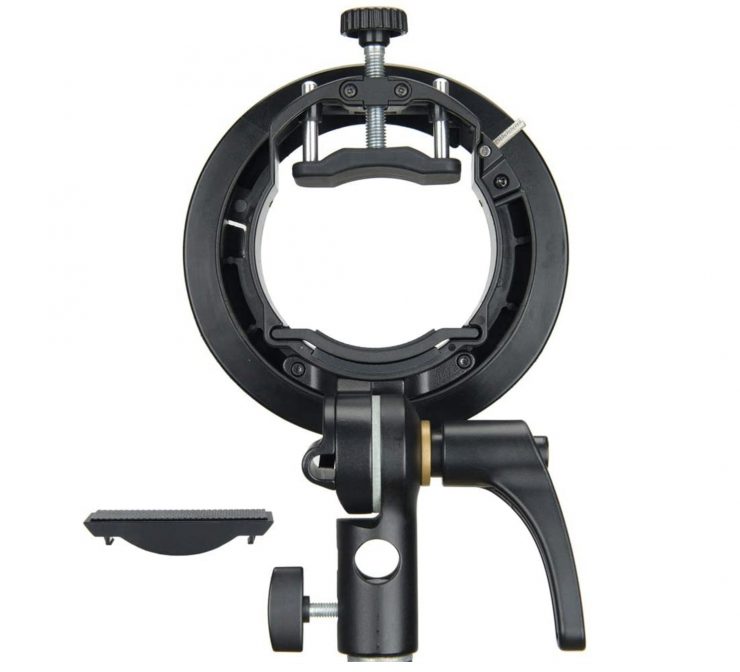
Now, if you do want to turn it into Bowens mount you could just simply buy a Godox S2 Speedlite S-Type Bracket Bowens Mount. While this isn’t the prettiest solution it will work and then you can use existing Bowens mount light modifiers you may already own.
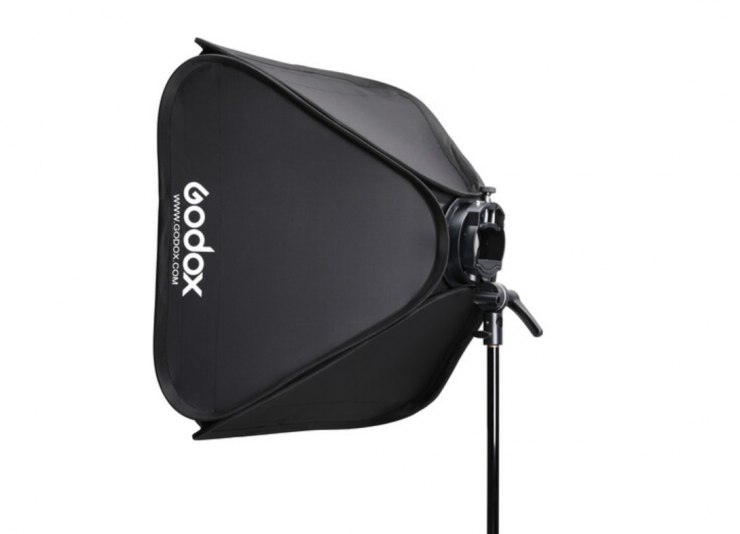
You can also get the Godox S2 Speedlite Bracket with Softbox & Carrying Bag Kit (23.6 x 23.6″) $44.90 USD.
Godox will also sell different reflectors for the ML60bi. The other options are:
- RFT-23 15°
- AD-R14 Reflector
- AD-R13 Reflector & AD-AS Adapter + SN04 Snoot
- AD-R13 Reflector + BD10 Barndoor Kit
Godox does also offer the RC-A6 optional remote controller for the ML60bi.
Real-World Performance & Quality of Light
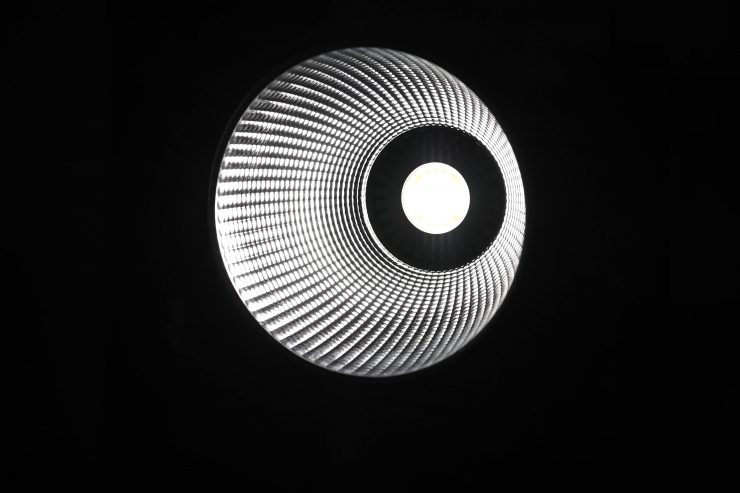
As I always say, photometric scores only tell you part of the story. So let’s find out if the scores from Godox ML60bi translate into good real-world performance.
The photometric data can only give me scientific data and it is much more important for me to see how the light looks and performs.
Unfortunately, it is very hard at the moment with the Coronavirus for me to showcase the strengths of the light. I live in Japan in an apartment so there isn’t a lot of space to do much testing. I apologize that I can’t do more!
Unfortunately, I couldn’t test out the light with a softbox because the test unit that was sent out didn’t come with the optional Bowens-S adapter.
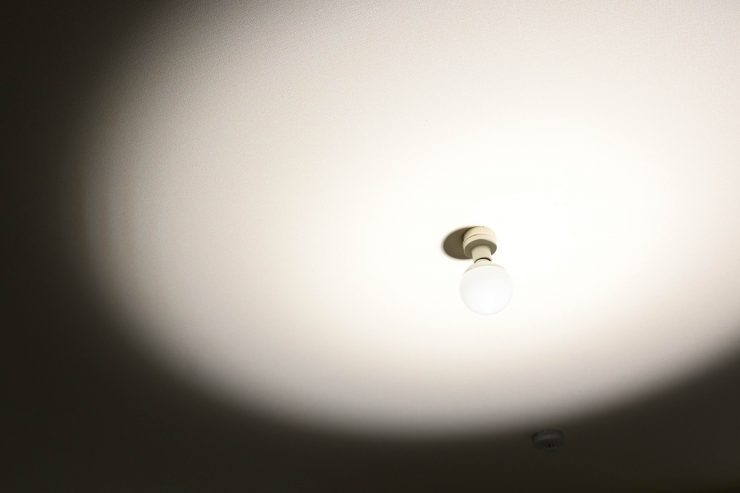
The Standard 60° Reflector doesn’t appear to have been optimized for the fixture. Above you can see that on the edges of the beam angle you can see the stripe elements from the COB.
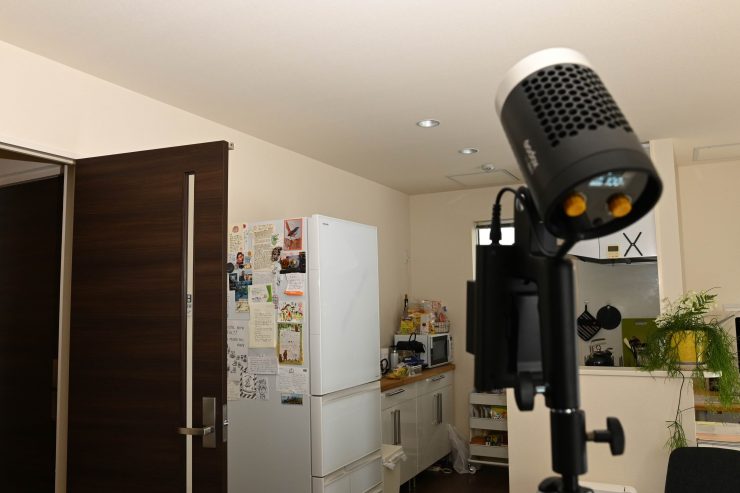

Light On 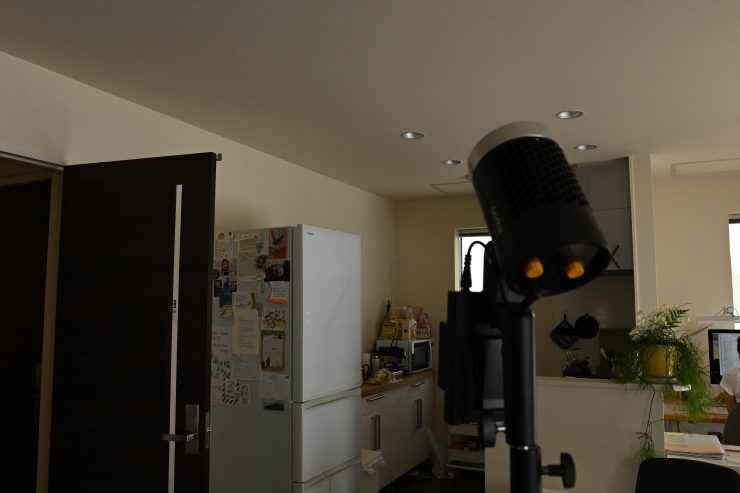
Light Off
When used open face the light does have a nice wide beam spread and you can add a nice amount of soft fill by punching the light straight into a ceiling. This is nice if you want to just bring up illumination levels and make it appear as though the light source is coming from a practical.
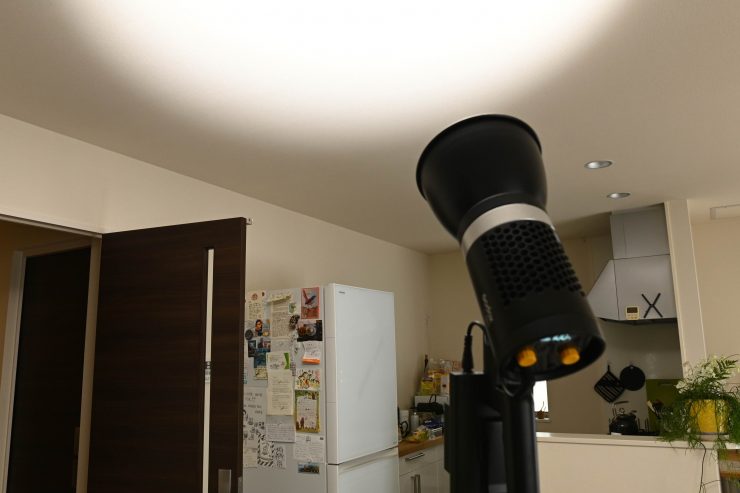

Light On 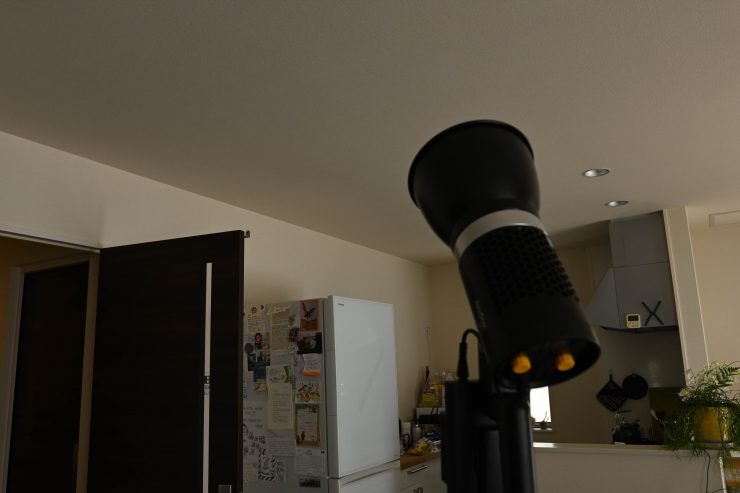
Light Off
If you attach the 60-degree reflector you can see what the difference is above.
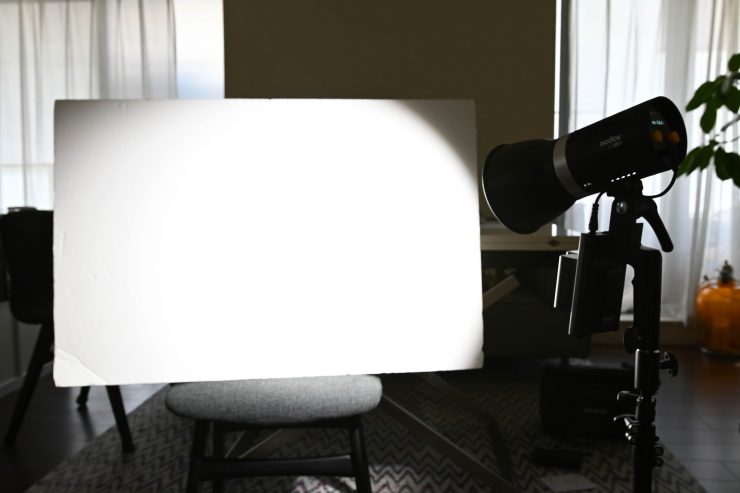
It also works well when you punch the light into some polyboard. Above are some quick examples using just one light with the 60-degree reflector attached and a piece of polyboard placed at various angles. The light was set at 50% intensity.
Who is the Godox ML60bi aimed at?
You could use the Godox ML60bi for lots of different applications, but the light is certainly being aimed at budget-conscious shooters who want a good quality, small-sized, budget-friendly COB fixture.
It is priced to appeal to entry-level content creators and owner-operators who are looking for a small-sized lighting solution that can be run via batteries and won’t take up a lot of space if you are traveling. By attaching a light modifier such as a soft box, you can create a nice soft light, and conversely, you could use it as a harder source with just the reflector.
The Godox is likely to appeal to the same target audience that would be looking at some of the offerings from Aputure and other companies.
Price & Availability
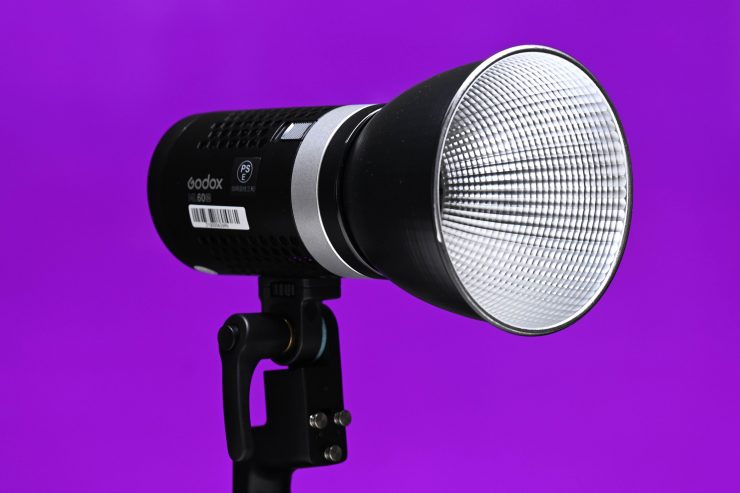
The Godox ML60bi retails for $299 USD. This makes it a very appealing prospect for those shooters who are not looking to spend a lot of money.
You can also buy it on Amazon.
In Japan, you can purchase the light for ¥37,270.
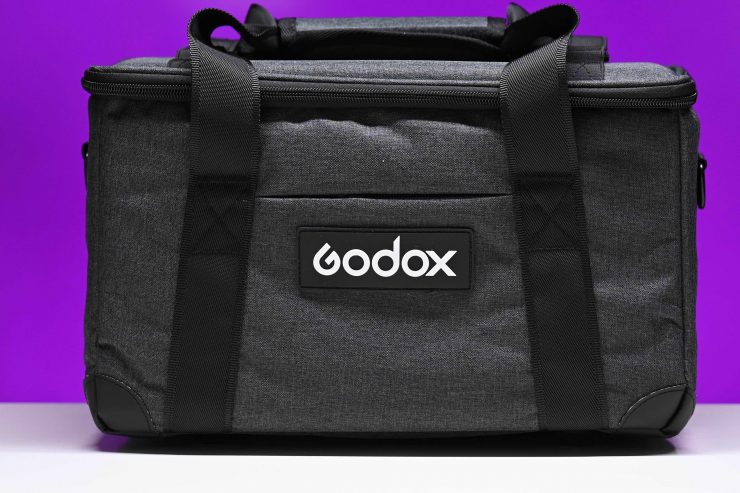
In the box you get:
- Godox ML60Bi LED Light
- Grip
- Battery Box
- Adapter
- Reflector
- Lamp Cover
- AC Power Cable: 16.4′
- DC Power Cable: 5′
- DC Cable: 8″
- Adapter Holder
- Carrying Case
There actually isn’t a ton of options out there if you are looking for a Bi-color 60W COB fixture, in fact, the only other comparable fixture I could find was the Nanlite Forza 60B. Most of the other options are Fresnels.
Below you can see how the price compares to some of the other 60W COB Bi-Color LED Lights. I have compared a couple of Fresnel options that have similar power draws.
Conclusion
The Godox ML60bi is a solid, affordable light that offers a decent amount of output, and good color accuracy.
The interface and operating system are reasonably straightforward and easy to use, as is the app. You are going to probably have to purchase an optional Bowens Mount adapter if you want to use this light with a large array of lighting modifiers as the options for mounting lighting modifiers to the standard Godox mount are quite limiting.
There really aren’t any glaring flaws with the ML60bi. The only complaint I have is the rotation of the light when it is used on the holder is a bit limiting and the battery mounting plate seems to be cheaply made and it isn’t easy to remove from the handle.
With a lot of modern LED lights, the quality of the LEDs being used is very similar, even across the price spectrum. What separates the lights comes down to build quality, features, and usability.
The Godox may not be quite as polished as some other fixtures, but again, this is a light that only costs $299 USD. The ML60bi offers great value for money and it is certainly a good light if you require a portable fixture that can be run off batteries.
It may well be a lower-cost option that some shooters are likely to write it off based on its low price, however, you shouldn’t sleep on this fixture as it is a solid offering that ticks a lot of boxes.
Like what we do and want to support Newsshooter? Consider becoming a Patreon supporter and help us to continue being the best source of news and reviews for professional tools for the independent filmmaker.

